Yachting World
- Digital Edition


Dinghy sailing: why it’s great for beginners and keelboat sailors
- Toby Heppell
- June 30, 2022
Dinghy sailing helps improve your understanding of a wide variety of skills, whether you are just starting out or a seasoned keelboat sailor, sailing a dinghy is a hugely rewarding pastime

Dinghy sailing – whether racing or as a leisure activity – is one of the best ways to improve your skill level whether you’ve no experience of sailing, race 50ft yachts offshore or cruise the coast in a 30ft bilge-keeler.
It is no coincidence that some of the world’s top sailors either started out dinghy sailing or continue to dinghy sail as a pastime. But many sailors, particularly those who come to the sport of sailing as an adult will only have limited dinghy sailing experience.
Though keelboat sailing and dinghy sailing are ostensibly the same sport, the two have a number of small differences, which transfer from one to the other to make you a better sailor generally.
However, this does also mean that no matter how good a keelboat sailor you are, jumping straight into a dinghy may come as something of a shock and vice versa.
What is a dinghy?
The difference between a dinghy and a keelboat can be difficult to define simply. Typically a sailing dinghy does not have a weighted keel in order to keep it upright.
However, there are boats many would consider to be a dinghy that do have a weighted keel, so this is not a strict definition.
Dinghies are also typically under 20ft and are not designed to sail in ocean going conditions. This, alongside the lack of a keel, typically means dinghies are much more manoeuvrable, faster to accelerate and more responsive to body position.
It’s these traits that make dinghy sailing such a boon in terms of improving your understanding of sailing when on a keelboat.
Sit in the wrong place on a dinghy at the wrong time and you might well capsize. Do the same on a keelboat and the effect will be negative but not in quite so stark a manner – in fact, it can often be an almost imperceptible reduction in performance.
The same is true of sail trim, accelerating and slowing down and a whole raft of other boat handling and sail handling skills that are vital to understanding how best to control a boat.
Finally, in terms of the difference between the two, dinghies usually only have one or two sailors onboard, meaning that all the jobs need to be either undertaken by one person or shared equally between two. This, in turn, means that a day out sailing a dinghy provides more opportunity to practise a wider variety of skills as compared to being one of a wider number of crew on a keelboat.

Laser/ILCA dinghies in Antigua racing as part of Bart’s Bash, the worldwide sailing charity race, raising funds for sailing communities affected by the 2017 hurricanes
Where to go dinghy sailing
In theory you can sail a dinghy on almost any publicly accessible piece of water, but publicly owned launching facilities tend to be few and far between.
Given their lack of communication equipment and their relative lack of self-sufficiency as compared to a keelboat, it’s advisable to have some sort of safety cover available should you get into trouble.
For this reason, the traditional way to go dinghy sailing is to join your nearest sailing club on an annual or trial membership and borrow a club boat (if they are available) to start sailing regularly.
Article continues below…

RS Aero – A Game Changer?
Lighter than most people’s launching trolleys, RS’ new single hander could prove to be a game changer – I found…
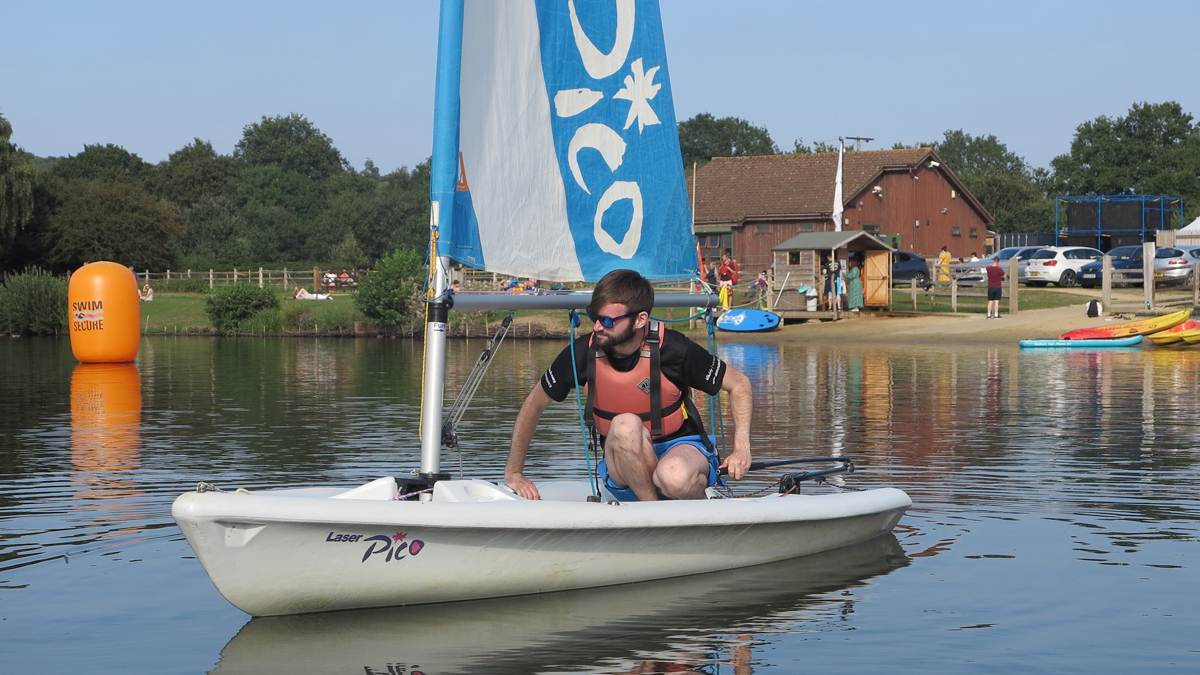
Learn to sail: What to expect from the RYA Dinghy Level 1 Start Sailing course
There can be few more forgiving places to learn to sail than Horseshoe Lake Activity Centre in Berkshire. This inland…
It’s not the most flexible system in the world and, increasingly, clubs are offering memberships on a pay-to-play basis.
Queen Mary Sailing Club in the UK based just west of London is one such club, which offers a gym-style membership of a monthly subscription which allows you to sail a wide variety of boats as often as you like (subject to booking etc.).
This can be a great way to go dinghy sailing or to try out dinghy sailing before making the commitment to an annual membership at a sailing club, or committing to the purchase of a boat.

A typical dinghy sailing club in the UK. Photo: David George / Getty Images
Although this is a growing area and there are plenty of sailing clubs offering a gym-style membership, it’s a long way from ubiquity, so the annual membership model is likely to be the best option for most.
It’s worth looking around you and seeing what options are available in the local area. In the UK, you will usually be living within easy access of a number of clubs, so you will be able to pick the club that is right for you.
If you are dinghy sailing in the USA, then your options will be limited, with sailing clubs being relatively fewer and further between.
What dinghy to buy
The first and easiest question to ask yourself is whether you plan on sailing alone or with another person and thus whether you are looking for a single or doublehanded boat (or something that can do both).
Ideally before taking the plunge and buying a dinghy you will have the chance to sail a variety of types of dinghy at a club you have joined, which should help you make your choice.
Most dinghies have an optimum weight so your size is a factor, but this is less of an issue if you are not planning on racing your dinghy.
Construction of the boat is a key consideration. Wood was the traditional dinghy material but this requires significant maintenance and is susceptible to rot if not well-kept – but it does look nice and is repairable with some simple wood-working skills.
Fibreglass and foam sandwich builds offer stiffness and are great for racing, but can become easily scratched or damaged and require a working knowledge of resin and glass fibre work to fix damage – or get a local boat builder to do it for you.
In the last 20 years, many beginner dinghies have been built from polyurethane or polyethylene and are rotomoulded. This process involves pouring liquid ‘plastic’ into a mould and rotating it while it sets to get an even distribution of the material, which forms the boats hull once cooled and released from the mould.

The Laser Pico is a rotomoulded boat, popular with sailing schools and beginners
Rotomoulding is not exactly new, so there are plenty of second hand examples on the market. These boats are very resistant to damage and are typically seen as ideal for the rental or beginner market.
Globally speaking, the Laser (recently being sold under the name ILCA) and the Sunfish are two of the most popular singlehanded dinghies. Both are fibreglass, but crucially wherever you are in the world there are likely to be plenty on the market at a variety of price points – the Sunfish being much more popular in the USA than Europe and the Laser/ILCA having a slightly more global presence.
Both these boats will also hold their second hand value reasonably well, so are good options for taking the plunge.
Catamarans are faster and more inherently stable than monohull dinghies, so can often be a good option for the starter sailor. It should be noted, however, that multihull sailing is, a slightly different skill to monohull sailing, so if you are looking to improve your skills on a monohull it might not be the very best option.

Catamarans lined up on the banks of the Swan River in Perth, Australia. Photo: lkonya / Getty Images
If you are considering racing, then the best advice would be to see what boats are being sailed at your local club. It might be that a slightly obscure boat is popular near where you live and sailing alongside others in the same type of boat is usually more fun than sailing around alone.

Sailing alongside others in the same type of boat can be more rewarding than sailing alone. Photo: Tim Platt / Getty Images
Dinghy Sailing Kit
Dinghy sailing is a pretty wet sport, with launching and retrieval usually seeing sailors in the water, regular soaking from waves and the possibility of capsizing all factors.
As such, particularly for those not blessed with warm warters and balmy breezes, buying a wetsuit is a pretty important thing to do.
You can go dinghy sailing in old trainers and a pair of trousers that you don’t mind getting wet, but these will be uncomfortable over an extended period of time on the water and will not keep you warm.
A buoyancy aid is also absolutely essential to help you float in the water should you fall out or capsize. Buoyancy aids are better than lifejackets for dinghy sailing as it’s entirely possible that you will be in the water more than once in a dinghy sailing session, so a manually inflating lifejacket will get in the wat after it has been set off once, and an automatically inflating one is likely to go off while you are in the boat itself if there is enough spray.
While a wetsuit and lifejackets are, in my opinion, must have items, trainers will be fine for a while – though you will probably want to invest in a pair of wetboots after not too long, which will be comfort and much warmer.
If you enjoyed this….
Yachting World is the world’s leading magazine for bluewater cruisers and offshore sailors. Every month we have inspirational adventures and practical features to help you realise your sailing dreams. Build your knowledge with a subscription delivered to your door. See our latest offers and save at least 30% off the cover price.
Sailing Dinghies: The Ultimate Guide for Beginners
by Emma Sullivan | Aug 13, 2023 | Sailboat Gear and Equipment

== Short answer: Sailing dinghies ==
Sailing dinghies are small, lightweight boats designed for recreational and competitive sailing. They typically have one or two sails and can accommodate a few people. Dinghies are versatile and popular for their simplicity, affordability, and ease of transportation.
Exploring the Thrilling World of Sailing Dinghies: A Comprehensive Guide
Sail away with us as we dive deeper into the thrilling world of sailing dinghies in this comprehensive guide. Whether you’re a seasoned sailor or a beginner looking to embark on your first sailing adventure, this blog post promises to be your ultimate companion in navigating the mesmerizing waters of dinghy sailing. So grab your life jacket and get ready for a wild ride!
1. Unveiling the Magic: What is a Sailing Dinghy? Before we set sail , let’s start at the beginning. A sailing dinghy is a small boat that is often single-handed and encompasses everything from simple recreational vessels to high-performance racing boats. These nautical wonders are built to withstand winds and waves, offering an exhilarating experience unlike any other.
2. Picking Your Perfect Dinghy: Choosing the right sailing dinghy can be overwhelming with the plethora of options available. From classic wooden designs to sleek modern ones, each boat has its own unique personality. We’ll walk you through the different types of dinghies and help you find “the one” that best suits your needs and dreams.
3. Rigging Made Simple: Once you’ve chosen your ideal sailing dinghy, it’s time for rigging—setting up all the lines and sails needed for smooth navigation. Fear not! We’ll break down this seemingly complex process into simple steps, ensuring that you’re able to rig like a pro in no time.
4. Learning the Ropes: Essential Sailing Skills: Now that you’re rigged up, it’s time to learn those essential sailing skills. From hoisting sails to adjusting controls, mastering proper tacking and jibing techniques – we’ve got you covered with our expert tips and tricks so that you can handle your dinghy like a seasoned sailor.
5. Racing: The Oceanic Adrenaline Rush: For those seeking an extra dose of excitement, consider dipping your toes into racing! Dinghy racing brings together sailing enthusiasts from all walks of life to compete in thrilling regattas. We’ll delve into the intricacies of race tactics, boat handling, and the sheer adrenaline rush that comes with competing against fellow sailors.
6. Safety First: Safety should always be paramount when setting sail . We’ll equip you with a comprehensive checklist that covers everything from life jackets and safety harnesses to understanding weather conditions and emergency procedures. With our guidance, you’ll navigate the waters with confidence and peace of mind.
7. Exploring Destinations: Dinghies on Different Terrains: Dinghies aren’t restricted to just open waters; they can also venture into lakes, rivers, and even challenging coastal areas. We’ll take you on an exciting journey across various terrains, highlighting the unique experiences each destination offers for dinghy sailors. Get ready to explore hidden coves, picturesque lakeshores, and breathtaking riverbanks!
8. Sailing Community: The Wind Beneath Your Wings: Lastly, we can’t forget about the vibrant sailing community that adds another layer of joy to dinghy sailing! We’ll dive into sailing associations, clubs, forums, and events that bring like-minded individuals together. Join this captivating community and fuel your passion for sailing by exchanging stories, tips, memories—and maybe even find your next sailing buddy along the way!
So there you have it—an in-depth guide to exploring the thrilling world of sailing dinghies! From choosing the right Dinghy to mastering essential skills whilst ensuring safety onboard—all while discovering picturesque destinations—this comprehensive guide has got everything covered for sailors seeking adventure or beginners looking to start their maritime escapades. So hoist those sails high and embrace the fantastic world of sailing!
Experience the Majesty of Yacht Sailing in Croatia
Embark on a spectacular sailing journey along the breathtaking coast of Croatia, where the pristine waters and stunning landscapes offer an unparalleled sailing experience. Croatia’s rich maritime heritage blends seamlessly with modern yachting adventures, making it a premier destination for sailors and enthusiasts alike.
Discover the charm of the Adriatic Sea aboard top-tier yachts provided by SkipperCity. Whether you’re a seasoned sailor or a beginner eager to learn the ropes, their expertly maintained fleet and knowledgeable crew ensure a safe and enjoyable voyage. Explore hidden coves, historic ports, and sun-soaked islands in a vessel that combines comfort and performance.
Ready to set sail on a Croatian adventure that combines the tradition of gaff rigged boats with modern luxury? Visit SkipperCity for an unforgettable maritime experience. Click below to watch their enticing sailing videos and to book your next sailing adventure!
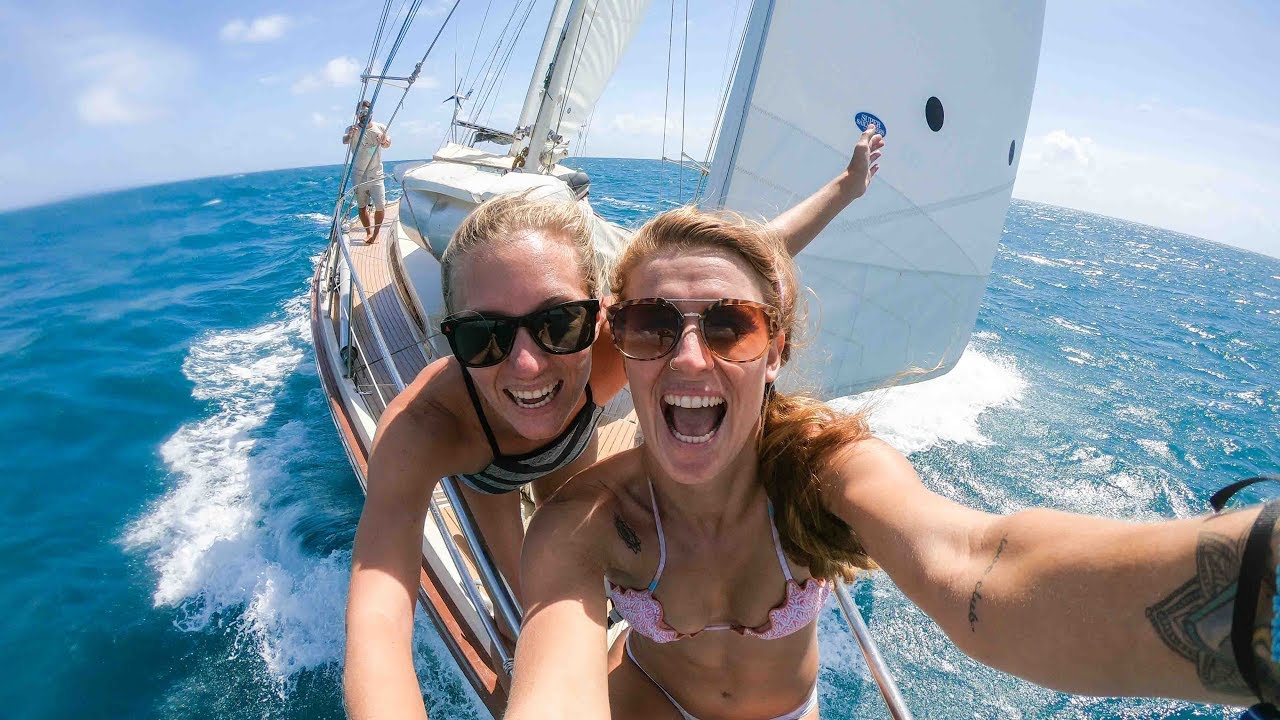
How to Sail Dinghies: Step-by-Step Beginner’s Handbook
Sailing is an exhilarating and captivating sport that allows individuals to harness the power of the wind and venture out into open waters . Amongst all types of sailboats, dinghies are particularly popular among beginners due to their smaller size, easy maneuverability, and versatility. Whether you are dreaming of cruising along tranquil lakes or racing against the wind, this step-by-step beginner’s handbook will equip you with the necessary skills and knowledge to embark on your sailing journey.
1. Choosing a Dinghy As a beginner, it is crucial to select a dinghy that suits your skill level and sailing ambitions. Opt for a stable design such as a Laser, Optimist, or RS Tera – these dinghies provide excellent stability while allowing room for growth as you become more experienced. Collaborate with expert sailors at your local yacht club or seek advice from seasoned sailors who can guide you in making the best choice.
2. Understanding Components Before venturing onto the water, let’s familiarize ourselves with the basic components of a dinghy. Start by acquainting yourself with terms like tiller (used for steering), mainsheet (controls sail position), halyard (raises sails), jib (front sail), boom (lower horizontal spar), and kicker (controls boom height). Knowing these names will greatly enhance your understanding when reading about techniques specific to each part .
3. Rigging Your Dinghy Rigging refers to installing and setting up various components before setting sail . Begin by hoisting the mast using the halyard until it stands vertically while ensuring all ropes are untangled and attachments secure . Next, attach sails properly, secured at both luff (leading edge) and leech (trailing edge) using suitable tension. Finally, connect control lines like mainsheet, kicker, jib sheets – keeping an eye on correct length and tension as you rig.
4. Getting Underway With your dinghy rigged and ready, it’s time to set sail ! Begin by launching the dinghy onto the water, either by sliding it off a ramp or gently easing it from a trailer. Once afloat, adjust the rudder and centerboard position to ensure stability. Steer clear of shallow waters, submerged objects, or excessive waves during this process. Bear in mind that gentle breezes are ideal for beginners to get accustomed to sailing techniques.
5. Basic Sailing Techniques To move forward, position yourself on the windward (upwind) side of the boat while holding onto the tiller extension with one hand. Slightly lean out over the water to balance weight distribution as you catch an appropriate angle to sail efficiently toward your desired destination. Maintain awareness of wind direction by feeling its effect on your face or by watching telltales attached to sails’ edges.
6. Tacking and Gybing Tacking and gybing refer to changing direction while sailing upwind and downwind , respectively. To tack (change direction toward the wind), bring the bow of your boat through the wind, ensuring smooth movements with trim adjustments on both sails once you cross over. Similarly, when gybing (changing direction away from the wind), ensure safe control of both boom and mainsheet while allowing maneuvering space for smooth transition .
7. Safety First! Sailing adventures must prioritize safety above all else – especially as a beginner! Always wear appropriate personal flotation devices (PFDs) that match local regulations and weather conditions; they can be lifesaving if unexpected incidents occur. Additionally, learn how to capsize safely and recover using techniques like righting lines or rescues by following reputable training programs available at yacht clubs or sailing schools.
8. Expanding Your Skills Once you become proficient with basic sailing maneuvers, challenge yourself by learning more advanced skills. Expand your knowledge about racing tactics, starting procedures, or even basic maintenance tips to keep your dinghy in top shape. Engage with fellow sailors and join sailing events or classes that can provide extensive learning opportunities, helping you progress from a beginner to an expert sailor!
Sailing provides an escape into the embrace of nature’s forces while cultivating valuable life skills such as self-confidence, problem-solving, and resilience. By following this step-by-step beginner’s handbook on how to sail dinghies, you’ll embark on a thrilling adventure that transcends the boundaries of land. So grab your lifejacket, adjust your sails, and immerse yourself in the enchanting world of dinghy sailing – where endless possibilities await!
Frequently Asked Questions about Sailing Dinghies: Everything You Need to Know
Introduction: Sailing dinghies are small , lightweight boats that are perfect for those seeking adventurous water experiences. Whether you’re a beginner or an experienced sailor, sailing dinghies offer a thrilling way to explore the open waters. However, as with any sport or hobby, it’s natural to have questions and seek information before diving in. In this blog post, we aim to answer some of the frequently asked questions about sailing dinghies and provide you with everything you need to know.
1. What is a sailing dinghy? A sailing dinghy is a small boat typically designed for one to four individuals. It features a single mast with a mainsail and often has additional sails like jibs or spinnakers. The compact size and maneuverability of dinghies make them excellent vessels for racing or recreational sailing purposes.
2. How do I choose the right sailing dinghy for me? Choosing the right sailing dinghy depends on various factors such as your skill level, intended use, budget, and personal preferences. Beginners usually opt for stable and forgiving boats like Optimists or Laser Picos, while experienced sailors may prefer high-performance boats such as 29ers or RS Fevas. Consider consulting with experts at a reputable boatyard who can guide you in selecting the most suitable option based on your needs.
3. Is it difficult to learn how to sail a dinghy? Learning how to sail a dinghy can be both challenging and rewarding. While basic skills can be acquired relatively quickly, mastering advanced techniques takes time and practice. Attending certified training courses with qualified instructors is recommended as they will teach you the fundamentals of sailing technique, safety procedures, wind dynamics, and capsize recovery methods.
4. Can I go solo on a sailing dinghy? Absolutely! Many people enjoy solo sailing as it provides tranquility and solitude on the water. However, venturing out alone requires additional precautions and expertise. It’s crucial to inform someone onshore about your plans, wear proper safety gear such as a life jacket, and ensure you’re confident in handling the boat single-handedly.
5. Are sailing dinghies safe? Sailing dinghies are generally considered safe; however, like any water activity, certain risks exist. Adhering to safety guidelines is essential for a secure sailing experience . Always check weather conditions before heading out, be mindful of other boats and potential obstacles, carry suitable safety equipment, and stay updated on maritime regulations specific to your location.
6. What should I wear when sailing a dinghy? Comfortable clothing that allows ease of movement is recommended while sailing dinghies. Dress according to the climate but be prepared for unexpected changes in weather conditions by layering your clothes. Wearing non-slip shoes is advisable along with a sun hat or cap and sunglasses to protect yourself from the sun’s glare.
7. How can I improve my racing skills in a sailing dinghy? Improving your racing skills requires dedication and practice. Join local sailing clubs or associations that organize races where you can compete against others and receive valuable feedback from experienced sailors. Additionally, studying resources like books or online tutorials on racing tactics can help you understand advanced techniques such as optimizing boat speed, utilizing wind shifts effectively, and strategic positioning during regattas.
Conclusion: Sailing dinghies offer an exhilarating world of adventure on the water for both beginners and seasoned sailors alike. By choosing the right boat for your skill level and preferences, acquiring proper training, adhering to safety guidelines, and continuously honing your skills through practice and competition, you’ll find yourself embracing all that this exciting sport has to offer. So grab a sailboat that suits you best and let the winds take you on unforgettable journeys!
Top Reasons Why Sailing Dinghies are Perfect for Adventure Enthusiasts
Do you have an insatiable appetite for adventure? If the answer is yes, then look no further than sailing dinghies – the ultimate vessel for thrill-seekers and explorers alike. Brimming with excitement, these compact and versatile boats are tailor-made to provide adrenaline junkies with an unforgettable experience on the open water . In this blog post, we will delve into the top reasons why sailing dinghies are perfect for adventure enthusiasts like yourself.
1. Portability: When it comes to exploring new horizons, convenience is key. Sailing dinghies offer unparalleled portability, making them a dream companion for any adventurer. Whether you’re embarking on a weekend getaway or planning a spontaneous trip to uncharted waters, their lightweight design allows for effortless transportation both on land and water. These vessels can be easily loaded onto trailers or car roofs, granting you the freedom to venture wherever your heart desires.
2. Versatility: Variety is indeed the spice of life, and sailing dinghies thrive in providing just that. Thanks to their compact size and versatile features, these boats can adapt to various conditions and environments with ease. From tranquil lakes to raging rivers or even coastal expeditions – nothing stands in your way! Seamlessly maneuverable, sailing dinghies deliver exceptional agility while cruising through tight spaces or navigating choppy waters – ensuring that every adventure unfolds without a hitch.
3. Freedom in simplicity: Adventure enthusiasts seek experiences that are pure and unadulterated – devoid of unnecessary complications. Sailing dinghies offer precisely that; their simplistic yet efficient design allows you to focus solely on what matters – embracing the thrill of exploration! With fewer components compared to larger vessels, maintaining, rigging up, and launching a sailing dinghy becomes hassle-free – giving you more time to uncover hidden treasures at sea.
4. Skill mastery: For those yearning to acquire new skills or refine existing ones, sailing dinghies make for the perfect tutor. As an adventure enthusiast, the journey itself is just as crucial as the destination, and mastering the art of sailing a dinghy enriches that journey tenfold. Whether you’re a novice taking your first steps in the world of sailing or an experienced sailor seeking a new challenge, these vessels provide ample opportunities to improve your seamanship skills through precise maneuvering and navigating ever-changing conditions.
5. Adrenaline rush: There’s nothing quite like the intoxicating rush of adrenaline when you surf on waves, harnessing the power of nature with every gust of wind. Sailing dinghies are specifically designed for thrill-seekers who crave that exhilarating sensation. With their lightweight construction and responsive handling, these boats allow you to push your limits and experience heart-pounding moments as you zip across water bodies at thrilling speeds – a symphony between man, vessel, and nature.
In conclusion, if you identify yourself as an adventure enthusiast in search of electrifying experiences on the high seas, look no further than sailing dinghies. Fuelled by their portability, versatility, simplicity, skill-building opportunities, and sheer adrenaline-pumping capabilities – these compact watercraft offer everything you need to embark on unforgettable voyages. Let sailing dinghies be your steadfast companion through uncharted territories as you brave wild waters and create memories that will last a lifetime!
Mastering the Art of Sailing Dinghies: Pro Tips and Techniques Revealed
Welcome to our blog where we delve into the exciting world of mastering the art of sailing dinghies. In this post, we will reveal some pro tips and techniques to help you become a skilled sailor in no time. So, hop on board and let’s set sail !
Sailing dinghies is a thrilling and challenging activity that requires a unique combination of skill, technique, and intuition. Whether you are a novice sailor or an experienced seafarer looking to enhance your skills, these pro tips will surely give you an edge.
1. Understanding the Basics: Before embarking on your sailing adventure, it’s important to grasp the fundamentals of sailing dinghies. Familiarize yourself with key terminology such as the tack, jibing, wind direction, and points of sail . This foundational knowledge forms the basis for any successful sailor.
2. Perfecting Your Balance: Maintaining balance on a dinghy is crucial to ensure stability and control over the vessel. Keep your weight evenly distributed while moving around the boat and use slight body movements to control its motion. Practice regularly so that balancing becomes second nature.
3. Harnessing the Wind: As any sailor knows, understanding wind direction is essential when maneuvering a dinghy efficiently . Watch out for telltale signs such as ripples on the water’s surface or observing flags nearby. Adjust your sails accordingly to maximize their effectiveness and propel your dinghy forward with precision.
4. Trimming Like a Pro: Properly trimming your sails can make all the difference in how your dinghy performs on the water. Experiment with different sail settings to find what works best in different wind conditions – too loose and you lose speed, too tight and you risk capsizing.
5.Mastering Tacking and Jibing: Tacking (turning into the wind) and jibing (turning away from the wind) are critical maneuvers that require finesse and precise timing. Practice these techniques to optimize your dinghy’s speed and maintain control while changing direction .
6. Utilizing Your Senses: Sailing is an art that relies not only on technical knowledge but also on the ability to sense and interpret the conditions around you. Sharpening your senses – observing changes in wind, water movement, and other boats – will help you anticipate potential challenges and make informed decisions.
7. Understanding Weight Distribution: In sailing dinghies, weight distribution can greatly impact performance. When going upwind, move forward in the boat to better slice through waves. Conversely, when heading downwind, shift your weight backward to keep the bow from digging into the water.
8. Learning from Others: Never underestimate the power of learning from more experienced sailors. Attend sailing workshops or join communities where you can interact with like-minded individuals who can share their wisdom and experiences with you.
9. Embracing Safety Measures: Safety should always be a top priority when sailing dinghies. Wear a personal flotation device (PFD), understand basic first aid procedures, and be mindful of weather conditions before setting out on the water.
10. Practicing Dedication and Perseverance: Last but not least, mastering the art of sailing dinghies requires dedication and perseverance. There may be moments of frustration or setbacks along the way, but don’t give up! With time and practice, you’ll become a skilled sailor capable of maneuvering any challenging situation.
So there you have it – our pro tips and techniques for mastering the art of sailing dinghies revealed! Remember to approach this exciting adventure with curiosity, a thirst for knowledge, and a dash of humor along the way because after all, sailing is meant to be exhilarating!
From Landlubber to Sailor: Embark on Your Sailing Journey with Dinghies
Are you tired of keeping your feet firmly planted on dry land? Have you ever imagined yourself gliding through the open waters, feeling the wind in your hair and the waves beneath your feet? Well, it’s time to turn those dreams into reality!
Embarking on a sailing journey can be an exhilarating and transformative experience . And what better way to immerse yourself in this world than by starting with dinghies? Don’t be fooled by their small size; these little boats are packed with big potential. So, put on your sea legs, grab hold of the tiller, and let’s dive into why dinghies are the perfect vessel for you to transition from a landlubber to a full-fledged sailor.
Firstly, let’s address the elephant in the harbor – why choose dinghies over larger sailboats ? Well, besides being cute and compact, dinghies offer numerous advantages that make them ideal for beginners. Their smaller size means they are easier to handle and maneuver compared to larger boats . This allows beginners like yourself to gain confidence and develop essential sailing skills without feeling overwhelmed.
One of the standout features of dinghies is their responsiveness. Unlike larger sailboats that may require an entire crew or complex systems, dinghies respond promptly to every adjustment you make. Just a slight tweak of the sails or adjustment of the rudder can result in immediate changes in speed and direction. This level of control not only allows you to fine-tune your sailing techniques but also provides an instant sense of accomplishment as you navigate across the water .
Another fantastic aspect of sailing dinghies is their versatility. Whether you prefer serene lake outings or exciting coastal adventures, there’s a dinghy suited for every type of environment. From lively racing models designed for adrenaline junkies to stable cruisers perfect for leisurely exploration, dinghies come in a wide range of types to match your preferences and skill level.
But wait, there’s more! Dinghies also offer the opportunity for endless learning and growth. As you become more comfortable on the water, you can experiment with different sailing techniques, try out various rigs, and even explore racing competitions if that tickles your fancy. The learning curve is never-ending but always rewarding, ensuring that every session aboard a dinghy brings new challenges and triumphs for you to conquer.
Now that we’ve established why dinghies are the go-to choice for aspiring sailors like yourself, it’s time to address the other vital aspect – developing your sailing skills. While embarking on this journey may seem daunting at first, fear not! There are numerous training programs available specifically tailored to beginners starting their adventure with dinghies .
These programs usually begin with thorough instruction on boat handling, rigging, basic maneuvers such as tacking and gybing, and essential safety procedures. Following this initial training period, you’ll have the chance to put theory into practice as you take control of your very own dinghy under the watchful eye of experienced instructors. Their guidance will ensure you navigate any obstacles smoothly while building confidence in your abilities.
The beauty of learning through hands-on experience is that by the end of these training programs, you won’t just be equipped with theoretical knowledge or basic sailing skills; rather, you’ll have developed a deeper understanding of wind patterns, currents, navigation principles – things that truly make one a skilled sailor.
So there you have it – from landlubber to sailor. By choosing to embark on your sailing journey with dinghies as your vessel of choice, you’re setting yourself up for an adventure filled with excitement, growth, and endless possibilities. So pack your sunscreen, don your sailor hat (optional), and get ready to set sail into a world brimming with freedom and wonder. Your journey awaits!
Recent Posts

- Sailboat Gear and Equipment
- Sailboat Lifestyle
- Sailboat Maintenance
- Sailboat Racing
- Sailboat Tips and Tricks
- Sailboat Types
- Sailing Adventures
- Sailing Destinations
- Sailing Safety
- Sailing Techniques
- New Sailboats
- Sailboats 21-30ft
- Sailboats 31-35ft
- Sailboats 36-40ft
- Sailboats Over 40ft
- Sailboats Under 21feet
- used_sailboats
- Apps and Computer Programs
- Communications
- Fishfinders
- Handheld Electronics
- Plotters MFDS Rradar
- Wind, Speed & Depth Instruments
- Anchoring Mooring
- Running Rigging
- Sails Canvas
- Standing Rigging
- Diesel Engines
- Off Grid Energy
- Cleaning Waxing
- DIY Projects
- Repair, Tools & Materials
- Spare Parts
- Tools & Gadgets
- Cabin Comfort
- Ventilation
- Footwear Apparel
- Foul Weather Gear
- Mailport & PS Advisor
- Inside Practical Sailor Blog
- Activate My Web Access
- Reset Password
- Customer Service

- Free Newsletter

Ericson 41 Used Boat Review

Mason 33 Used Boat Review

Beneteau 311, Catalina 310 and Hunter 326 Used Boat Comparison

Maine Cat 41 Used Boat Review

Tips From A First “Sail” on the ICW

Tillerpilot Tips and Safety Cautions

Best Crimpers and Strippers for Fixing Marine Electrical Connectors

Thinking Through a Solar Power Installation

Getting the Most Out of Older Sails

How (Not) to Tie Your Boat to a Dock

Stopping Mainsheet Twist

Working with High-Tech Ropes

Fuel Lift Pump: Easy DIY Diesel Fuel System Diagnostic and Repair

Ensuring Safe Shorepower

Sinking? Check Your Stuffing Box

The Rain Catcher’s Guide

Boat Repairs for the Technically Illiterate

Boat Maintenance for the Technically Illiterate: Part 1

Whats the Best Way to Restore Clear Plastic Windows?

Mastering Precision Drilling: How to Use Drill Guides

Giving Bugs the Big Goodbye

Galley Gadgets for the Cruising Sailor

Those Extras you Don’t Need But Love to Have

UV Clothing: Is It Worth the Hype?

Preparing Yourself for Solo Sailing

How to Select Crew for a Passage or Delivery

Preparing A Boat to Sail Solo

On Watch: This 60-Year-Old Hinckley Pilot 35 is Also a Working…

On Watch: America’s Cup

On Watch: All Eyes on Europe Sail Racing

Dear Readers

Chafe Protection for Dock Lines
- Sailboat Reviews
Practical Sailor Reviews Seven Performance-Sailing Dinghies
Agile, fun boats like the classic sunfish and new hobie bravo keep the smile in summer sailing..
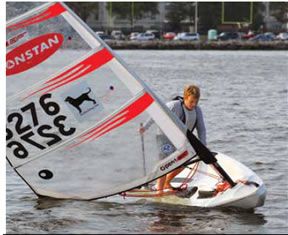
Photos by Ralph Naranjo
Messing around in small boats is a global theme-one thats embraced by pond-bound pram sailors, river riders, lake voyagers, and all of us who call salt water home. The purpose of this sailing dinghy profile is to highlight seven very interesting little sailboats. Some are new designs, and others have stood the test of time, but all are currently being manufactured, and each drives home just how much fun sailing close to the water can be.
This isn’t a shootout among anorexic speedsters or a report on the best tender that doubles as a sailing dinghy. Its a look at perennials like the Optimist, Sunfish, and Laser-legendary competitors that have helped spawn some of the best sailors in the world. But its also a look at three of the newest entries in the dinghy-sailing circle: Bics Open, Hobies Bravo, and Laser Performances Bug. These agile, new sailing dinghies are chock full of fun and boat-handling features to inspire kids of all ages to go sailing.
Well also take a look at Chesapeake Light Crafts kit approach to getting started-one that offers meaningful lessons and tangible rewards well before the boat ever hits the water.
Scale down an Open 60, add sail technology long favored by windsurfers, and put it into play in a tough thermo-formed hull, and you have the makings for a new kind of watercraft. The result is a very interesting blend of performance and reliability that targets adolescent interest. When all is said and done, Bics boat is more akin to a sit-down windsurfer than a traditional Blue Jay. And like all good boats, its vying for attention not just based on performance, construction quality, and style, but just as importantly, on the price tag stuck to the hull.
The Open Bics light weight and wide, flat stern section means that even small chop can be surfed; and bursts of planing on a reach add a zing factor to dinghy sailing. The Open Bic is already an International Sailing Federation (ISAF)-sanctioned class, and fleets are developing around the US. Another bonus: Its an easily portable boat that can be carried like a windsurfer, adding excitement to a Sunday picnic at the beach.
The thermo-formed polyethylene hull is a modified hard-chine design with lots of beam aft. Sailed flat, the boat is agile enough to surf wavelets, and with a shape thats ergonomically friendly to hiking, the ensuing heel on the upwind leg puts just the right amount of chine into the water. In light air, careful control of heel can significantly reduce wetted surface.
The design team that developed the Open Bic saw it as a transition bridge from Optimist sailing to a more performance-oriented dinghy. An interesting innovation is that the Open Bic can be sailed with an Optimists rig and blades. This buy the hull only approach can be a significant incentive for parents with children outgrowing their Opti as fast as their boat shoes. However it wont be long before the kids want the fully turbo-charged feel delivered with the Open Bics well-shaped 4.5-square-meters rig, sail, and nicely foiled blades.
Bottom line: The Open Bic is fast, agile, and buckets of fun for kids uninspired by sailing in the slow lane.
Just when you think that Hobie Cat Co. has covered whats possible in beach-cat innovation, their design/engineering crew comes up with a new twist that reinvents the wheel. The Hobie Bravo is a good case in point.
In a recent visit to Backyard Boats ( www.backyardboats.com ) in Annapolis, Md., we got a good look at the Bravo. Nearly as narrow as a monohull but still quite stable, this quick-to-launch beach cat packs plenty of get-up-and-go. Its a simple to sail, entry-level boat that fast tracks learning the steer, sheet, and hike trilogy. The boat features a single, midline rudder and roto-molded hulls. The shape of the hulls provides enough lateral plane to allow a crew to make headway to windward.
The narrow (4 feet), 12-foot Bravo uses crew weight and hiking straps to add to the righting moment once the breeze is up. Whats done with webbing on larger cats has been converted to a shallow, rigid deck well on the Bravo. It does raise the weight of the boat to 195 pounds, but it offers comfortable seating plus room for cushions and a cooler. Kids or grown ups can have a Tom Sawyer-Huck Finn type of adventure aboard this fun little sailing machine. Or the family on a beach picnic can set it up and take turns speed reaching along a sandy shoreline.
The furling mast supports a roachy sail with slightly slanted vertical battens, helping to shape the boomless mainsail. The result is convenient sail handling, decent performance, and superior safety. Theres no boom to clobber the crew, and the roller-furled sail and mast are easily stepped in the tripod-like receiver. This interesting set of struts raises the top bearing point of the mast step and spreads rig loads out to the hulls. The furling mainsail offers the ability to reef, a big plus in a building breeze or when teaching children to sail.
Like all of the boats in the Hobie lineup, theres a wide range of specialty parts and fittings that make the boats fast to rig and easy to handle. The kick-up rudder is hung on gudgeons mounted in the center of stern, and just as rig loads have been effectively spread via the tripod step, the energy radiating from the large rudder is spread athwartships via a contoured deck element.
Bottom line: The boat is quick to rig, easy to launch, and responsive to beginners-more experienced sailors will have just as much fun power reaching when the breeze is up.
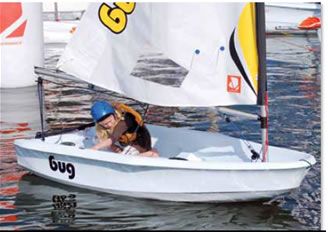
A pocket-sized club trainer, the Bug is an evolution of the kids trainer/club racer that leverages lessons learned in Optis, Dyers, and Sabots. It pulls together the logic of a stable hull shape and simple-to-sail rig, and puts it all in a cost-effective package.
Lending to its success is designer Jo Richardss ergonomic, roto-molded hull, a fabrication that is as close to zero maintenance as a boat can get. The straight out-of-the-mold polyethylene skin gets a few decals, and theres no wood to refinish or gelcoat to wax. These tough, abrasion-resistant hulls have a bumper boat tolerance thats a big plus when it comes to kids learning to sail. Best of all, owners can start with a learn-to-sail rig and upgrade to a more performance-oriented mast and sail package (41 or 56 square feet) that kicks performance into the fast lane.
Oars and an outboard motor bracket can be added to turn the little sailboat into a dual-purpose dinghy. Even the bow painters means of attachment makes sense-no projecting hardware ready to knick the topsides of unintended contacts. Instead, theres a recessed hole in the stem allowing a line to be lead through and a knot used to keep the painter in place.
Bottom line: Aimed at club programs and families look for boats that can be transported on the car top, the Bug is easy to rig and definitely kid friendly. The fact that its manufacturer, Laser Performance, is an international interest and a major player in the performance dinghy industry means that this boat and its parts will be around for a while.
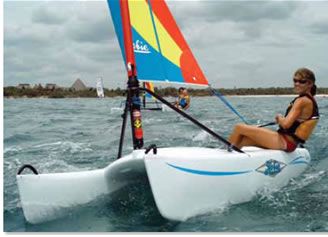
Photo courtesy of Hobie Cat Co.
Eastport Pram
Chesapeake Light Craft expedites boatbuilding for do-it-yourselfers looking to take their garage-built boats for a sail. The company pre-cuts parts, packs kits with all the materials, epoxy, and paint youll need, and leads homebuilders through a thoroughly detailed stitch-and-glue approach to assembly. Kits are available in various stages of completeness, ranging from plans only to the full package, including sail, hardware, running rigging, and paint.
The Eastport Pram is just shy of 8 feet, and the marine plywood and epoxy construction delivers a boat that weighs in, sans sailing rig, at just 62 pounds. Lighter than the comparatively sized Bug, this stiff, durable dinghy, rows like a real boat and sails comfortably with one or two aboard. In keeping with other good tender attributes, the Pram behaves under tow and is equally amicable when propelled by a small outboard or tacked up an estuary under sail.
Kit boatbuilding continues to have a niche following. Theres also an added-value feature worth noting: On one hand, the builder receives a box of pieces and the result of his or her endeavor leads to an aesthetic and utilitarian dinghy. In addition, the DIY skills the builder develops will be useful in other epoxy bonding, brightwork, or mono-urethane application projects. Such talents will benefit many other boat maintenance endeavors.
Whats hard to quantify is the sense of accomplishment derived from sailing a boat that you have built yourself. When the project is tackled in tandem with a child, spouse, or friend, the memories and the boat will last.
Bottom line: With neither sidedecks or a sealed hull, this is not a boat thats easy to recover from a capsize. So once the kids favor on-the-edge sailing in a building breeze, a non swamping, easier-righting boat is probably a better option. The Pram can then be put to use by their appreciative parents or grandparents.
Never in their wildest dreams did Bruce Kirby and Ian Bruce imagine that the Weekender (the Lasers original name) was destined to become an Olympic class sailboat and one of the most popular springboards for top-tier sailors in the world today. Originally envisioned as a car-topper for weekend campers, the cat-rigged, low freeboard sailing dinghy morphed from its original roots into a boat favored by college competitors and revered by generations of agile sailors of all ages. Even frostbiting winter sailors have locked onto the Laser.
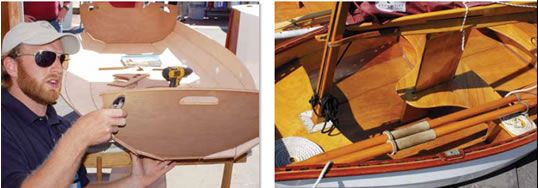
Designed in 1969, the Lasers first few years were anything but smooth sailing. Popularity grew quickly, but along with the limelight came plenty of consternation. Dubbed a surfboard not a sailboat by a growing cross-section of the yachting elite-many parents warned junior sailors to steer as clear of Lasers as they did sex, drugs and rock-n-roll. The campaign failed, and junior sailors in yacht club programs around the country fell into the grip of the new one-design dinghy-discovering the sailboats proclivity to plane.

Dyer Dhows languished in boat sheds across the country as a new theme in sailing took hold. Dubbed fast is fun by sailor/engineer Bill Lee, the young Merlin of Santa Cruz, Calif., took the theme to big-boat sailing, merging California culture with the Laser logic of light displacement and planing hull shapes.
Best of all, the Laser embraced the ideal of a tightly controlled one-design class that put people on the water in identical boats and left winning and losing races up to sailing skill and tactics rather than a boats performance edge. For decades, the boat has been the single-handed sailors choice among junior sailing programs, and with the addition of the Radial, 4.7 and M rigs, smaller competitors have also found the boat to be a great sailing platform. Today, theres some lawyer saber-rattling over the sale of the design rights, but the boat remains more popular than ever.
The sleeved sail, two-part spar, daggerboard, and kick-up rudder make the boat a quick-to-rig and fast-to-get underway dinghy. Light-air efficiency is good for a one-design sailboat, but this means that as the breeze builds, the non-reefable sail can become a handful in a hurry. In fact, the boats Dr. Jekyll-and-Mr. Hyde demeanor is what builds talent among Laser practitioners. The big boys block the mainsail and blast off for the layline, while lighter sailors heavy-weather tactics include more nuanced de-powering and feathering. In light air, the tables turn, and the winner is often the sailor who planes quickest on the reaches. The old guards surfboard slam may have held some credence after all.
Bottom line: The Laser is a timeless classic thats easily transported and is built for performance. Its well suited to adrenaline-seeking teens as well as the more fit adult crowd.
Designed in 1947 by Floridian Clark Mills, the utilitarian Optimist could be made out of two sheets of plywood-and from its inception, the Optimist was meant to link kids with the water. Slipping into obscurity in the U.S., the little pram found fertile ground to grow in northern Europe. With just a few tweaks, the Scandinavians took Millss lines and parlayed them into whats become the favored junior sailing trainer for kids from Detroit to Timbuktu. Statistics show that there are about 30 builders worldwide putting out approximately 4,000 boats each year. With about 130,000 boats class registered and an estimated 300,000 total hulls built (amateur and pro), theres plenty of reasons to get excited about an Opti.

The example weve chosen is the USA-built McLaughlin boat, both a demonstration of high-quality FRP construction and modern manufacturing techniques. Its also a boat that can be purchased in a range of performance-inducing iterations-upgrades designated as club, intermediate, advanced, and professional versions. Like all performance sailboats, stiffness and strength-to-weight ratio is important. But class rules include a minimum weight, so the most competitive hulls meet the mandatory lower limit but use good engineering and building technique to reinforce the daggerboard slot and mast step and produce overall stiffness.
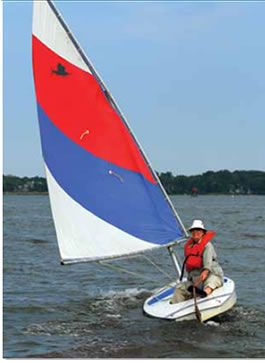
The low mast height and high aspect ratio sprit sail is very versatile, affording young (and small, 65 to 130 pounds) sailors a wide window of decent performance. The flat bottom, slab-sided hull is responsive to crew weight-driven trim changes, and the better the sailor, the more agile they become. Light-air performance is all about minimizing wetted surface and maximizing sail area projection. When the breeze starts to kick up, the sailor becomes the ballast, and the art of hiking, sheet handling, and tiller wiggling come into play.
Under careful adult supervision, two 6- to 8-year-olds can double-hand the friendly little dinghy, or one more-confident child can solo sail it. In fact, introducing kids to sailing with similar proportioned small prams has been a right of passage around for decades. A set of oarlock gudgeons can turn the pram into a functional dinghy thats also adaptable to the smaller Torqeedo outboard (www.torqeedo.com).
McLaughlin also markets a Roto-molded polyethylene version of the Opti and sells DIY kits for those who want to create their own wood version.
Bottom line: The Opti is like a first bicycle without the need for training wheels. The fact that at the last Olympics, over 80 percent of the winning sailors had gotten their start in an Optimist speaks well to the value of messing around in this particular dinghy.

Designed in 1951 by ice boaters Alexander Bryan and Cortland Heyniger, the hard chine Sunfish was the prototype board boat. In 1959, it made the transition into fiberglass, and over the following half-century, more than a quarter-million hulls would hit the water. Simplicity and decent sailing attributes combined with an attractive price to make the Sunfish the most popular one-design dinghy ever raced.
Far more than a platform for racers, these boats are an excellent training tool for sailors of all ages. Also built by Laser Performance, they reflect the fun of summer and put sailors in close contact with the water on which they sail. Its no surprise that the larger fleets coincide with warm water and many see going for a swim to be part and parcel of the low-freeboard experience.
The lateen rig is in keeping with the overall design concept and simplifies rigging. A short stub of a mast is stepped and a single halyard hoists the sail along with tilting V-shaped upper and lower booms.
The total sail area is nearly the same as the Laser, but the halyard hoist versatility of the lateen rig make it a handy beach boat and a little less daunting when the wind begins to build. The clean sail shape on one tack and deformation caused by the mast on the other tack are a slight drawback. The Laser rig is more efficient, but when caught out in a squall, its nice to be able to ease the halyard and dump the sail. Its also handy to be able to leave the boat tethered to a mooring, and the doused sail and short mast make it possible.
Multiple generations of sailors are often found sailing Sunfish, and the boat represents one of the best bargains to be found in the used boat market. When considering a pre owned boat, the potential buyer needs to take a close look at the daggerboard-to-hull junction and mast step, points where previous damage can create hard-to-fix leaks.
Bottom line: The Sunfish is a great beach boat that can turn a hot afternoon into a fun-filled water experience.
There were no losers in this group, and picking winners and runners-up proved a difficult task. The outcome had to be based on assumptions about how these boats would be used. For example, parents with a competitive 9-year-old who swims like a fish, always sprints for the head of the lunch line, and likes to steal bases in Little League probably have an Opti racer in the making. Less competitive junior sailors-future cruisers in the making-will do better learning aboard a Bug. Many newly formed sailing clubs target the boat as their trainer of choice.
The Bravo holds plenty of appeal for those with a lakeside cottage or a favored campground destination. Whether its a solo sail just before sunset or a fun race on Sunday, the quick to set up and put away features are a plus, and for those who feel that two hulls are better-the Bravo will hold plenty of appeal.
Serious competitors can campaign a Laser for life, and whether youre headed for a local district regatta or getting ready for the Olympic trials, the hull, rig, and sail remains identical-sort of like the Monaco Grand Prix being raced in a street legal Mustang.
Bic Opens new little speedster tickled our fancy, and as a trainer/performance boat crossover, it drew a strong nod of approval. Watching the junior sailors smiles as they sailed their Open Bics endorsed our opinion.
And if there is any boat that defines the essence of summer, the Sunfish takes the prize.
- The Art of Building with Thermal-setting Plastics

- Youth Safety Gear Top Picks
- Chesapeake Light Craft
- Hobie Cat Co.
- Las er Performance
- McLaughlin Boat Works
RELATED ARTICLES MORE FROM AUTHOR
Leave a reply cancel reply.
Log in to leave a comment
Latest Videos

What’s the Best Sailboats for Beginners?

Why Does A Sailboat Keel Fall Off?

The Perfect Family Sailboat! Hunter 27-2 – Boat Review

Pettit EZ-Poxy – How to Paint a Boat
Latest sailboat review.
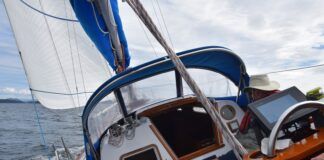
- Privacy Policy
- Do Not Sell My Personal Information
- Online Account Activation
- Privacy Manager
Dinghy Guide 101
- Dinghies 101
Dinghies, also known as sailing dinghies or dinghy sailboats, are versatile and agile boats that have gained immense popularity among sailing enthusiasts worldwide. These small watercraft offer a thrilling experience on the water, making them a perfect choice for both beginners and seasoned sailors. In this comprehensive guide, we'll delve into the world of dinghies, exploring different types, their benefits, and everything you need to know about sailing these charming vessels.
What are Dinghies?
Dinghies are small, open boats that are usually carried or towed by larger vessels. They serve a variety of purposes, such as transportation between a larger boat and the shore, recreation, racing, and as training boats for novice sailors. Due to their compact size, they are easy to handle and maneuver, making them ideal for navigating narrow waterways and crowded harbors.
Types of Sailing Dinghies
1. dinghy sailboats.
Dinghy sailboats are the most traditional and widely used type of dinghies. They come in various designs and materials, such as fiberglass, wood, or aluminum. Dinghy sailboats use the wind as their primary means of propulsion, with a main sail and, in some cases, a jib. These boats offer an excellent opportunity for learning to sail due to their simplicity and responsiveness to wind shifts.
2. Inflatable Dinghies
Inflatable dinghies, as the name suggests, are made from inflatable materials like PVC or Hypalon. These dinghies are incredibly lightweight and easily portable, making them popular among boaters who need a dinghy that can be deflated and stowed when not in use. Inflatable dinghies are also known for their stability and durability, making them suitable for various water conditions.
3. Rigid Dinghies
Rigid dinghies, often constructed from materials like fiberglass or aluminum, offer a stable and reliable sailing experience. They are sturdy and can handle rough waters with ease. Rigid dinghies are commonly used for fishing and exploring shallow waters, making them a versatile option for those who love to venture into remote areas.
Advantages of Dinghy Sailing
1. versatility and maneuverability.
Dinghies are incredibly versatile boats that can navigate in waters where larger vessels cannot venture. Their maneuverability allows sailors to explore hidden coves, creeks, and inlets that are off-limits to bigger boats, providing an opportunity for a unique sailing experience.
2. Learning to Sail
Dinghy sailing is an excellent way to learn the art of sailing. The smaller size and direct control over sails and rudder help beginners grasp sailing techniques quickly. Aspiring sailors can gain confidence in their skills, which can be later applied to larger boats.
3. Accessibility and Portability
Dinghies are easy to transport, launch, and retrieve, making them accessible to sailing enthusiasts without access to large marinas. Inflatable dinghies, in particular, can be deflated, folded, and stored in a compact bag, enabling sailors to take their dinghies wherever they go.
Dinghies for Sale: Finding the Perfect Boat
When considering purchasing a dinghy, several factors need to be taken into account.
1. New vs. Used Dinghies
New dinghies offer the advantage of warranty and customization, while used dinghies may come at a more affordable price. Evaluate your budget and preferences before making a decision.
2. Factors to Consider Before Buying
Consider the boat's size, material, and intended use. If you plan to sail in calm waters, inflatable dinghies might be a suitable choice. For more adventurous journeys, rigid dinghies might be the better option.
3. Top Brands for Dinghy Sailboats
Some renowned brands in the dinghy sailboat market include XYZ Sailboats, ABC Marine, and QRS Boats. Researching reputable brands can help you find a high-quality dinghy that meets your requirements.
Inflatable Dinghies: The Ideal Choice for Some
Inflatable dinghies offer unique benefits that make them the ideal choice for certain boaters.
1. Benefits of Inflatable Dinghies
Inflatable dinghies are lightweight, making them easy to carry and transport. They are also stable on the water, which is especially advantageous for anglers and divers who need a steady platform.
2. Top Features to Look for
When choosing an inflatable dinghy, consider features like reinforced hulls, multiple air chambers for safety, and convenient accessories such as oars and air pumps.
Sailing Dinghies Maintenance and Care
Proper maintenance is crucial to ensure the longevity and performance of your dinghy.
1. Cleaning and Storage Tips
Rinse your dinghy with fresh water after each use to remove salt and debris. Store it in a cool, dry place away from direct sunlight to prevent damage to the material.
2. Common Repairs and Maintenance Tasks
Inspect your dinghy regularly for signs of wear and tear, and address any issues promptly. Common repairs may include patching inflatable dinghies or fixing minor cracks in rigid dinghies.
Read our top notch articles on topics such as sailing, sailing tips and destinations in our Magazine .
Check out our latest sailing content:

The official website of the International Snipe Class

Regata Villa de Gijon
Gijon, Spain, August 25, 2024…

Trofeo San Roque
Villagarcia de Arosa, Spain, August 25, 2024…

Italian Master Nationals
Bracciano, Italy, August 25, 2024…
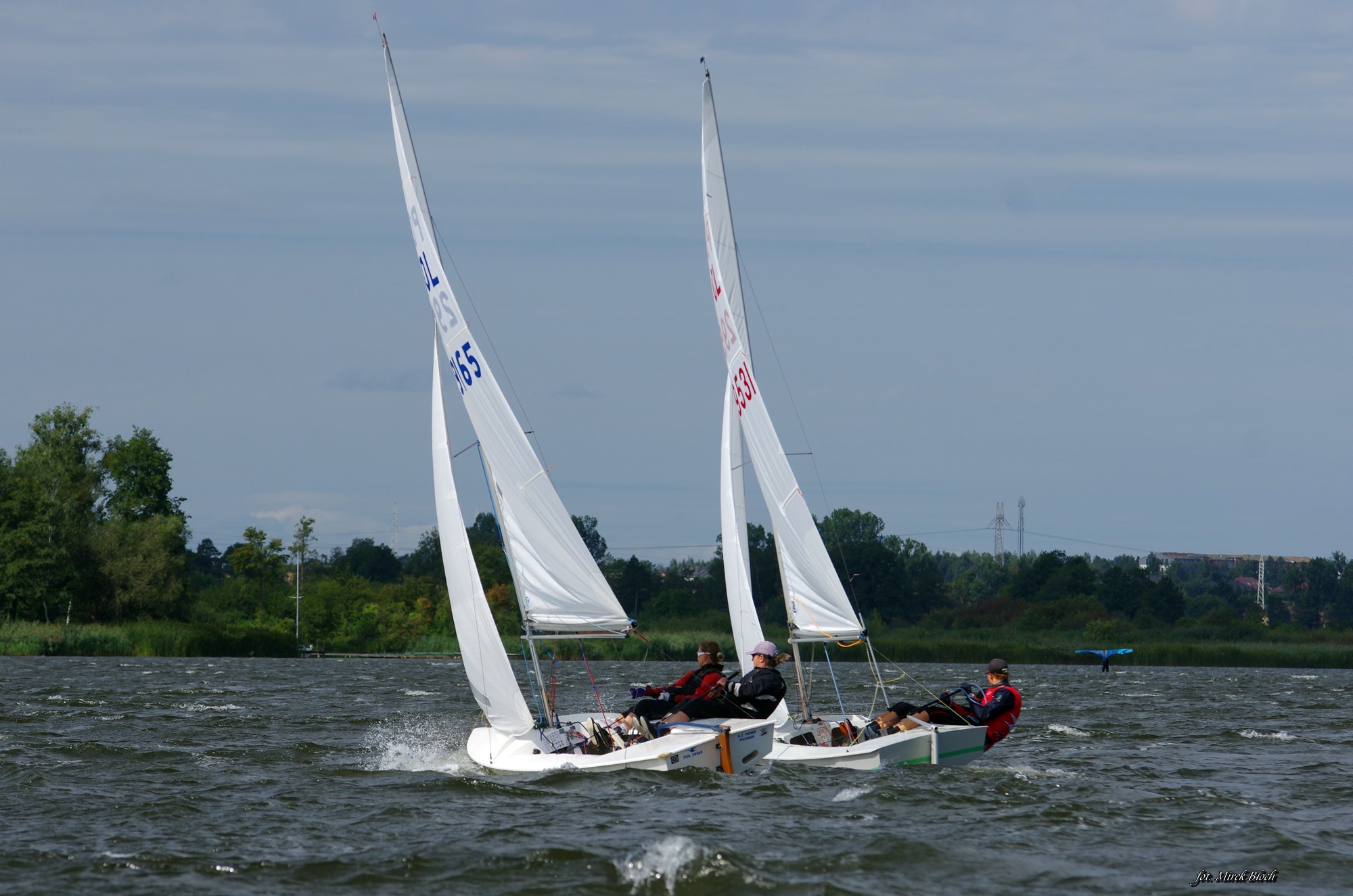
Polish Nationals – Final
Kiekrz, Poland, August 25, 2024…

Norwegian Master Nationals
Baerum, Oslo, Norway, August 25, 2024…
SCIRA Proposals 2024
2024 snipe worlds – registration open, 2024 for 2025 rules proposals posted, official statement on the use of jib luff height adjustment, new membership database for 2024.

All Japan Nationals – Final
2024 north american championship, european masters championship, 2024 snipe world championship, trofeo morin, comodoro rasco regatta, join the snipe class serious sailing, serious fun.
The Snipe is a two person dinghy that brings the well-balanced class motto “ serious sailing, serious fun ” to life at every regatta. It’s a class we can grow old in, with age-appropriate challenges and opportunities for every generation .
The Snipe Class International Racing Association (SCIRA) is a widely popular and well run organization all over the world. The Snipe Class offers the best racing calendar you can imagine – for champions and beginners, for juniors (under 21), women, masters (over 45) and mixed teams consisting of major events as World Championships, Europeans, South Europeans, South Americans, North Americans and Nordics, not to forget several international Snipe Regattas.
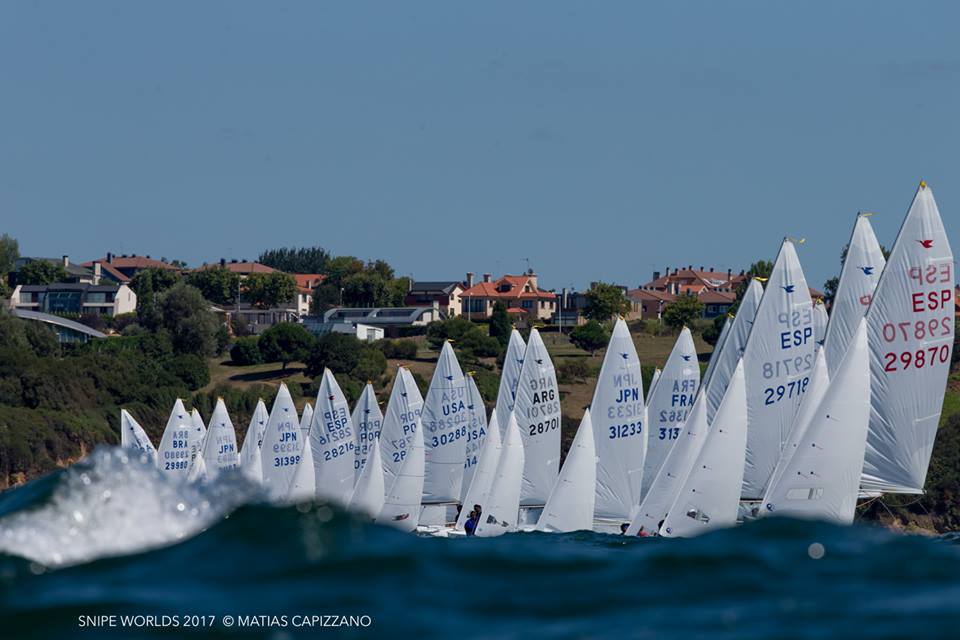
Sakaiminato, Japan, August 25, 2024…

Polish Nationals – Day 2
Kiekrz, Poland, August 24, 2024…
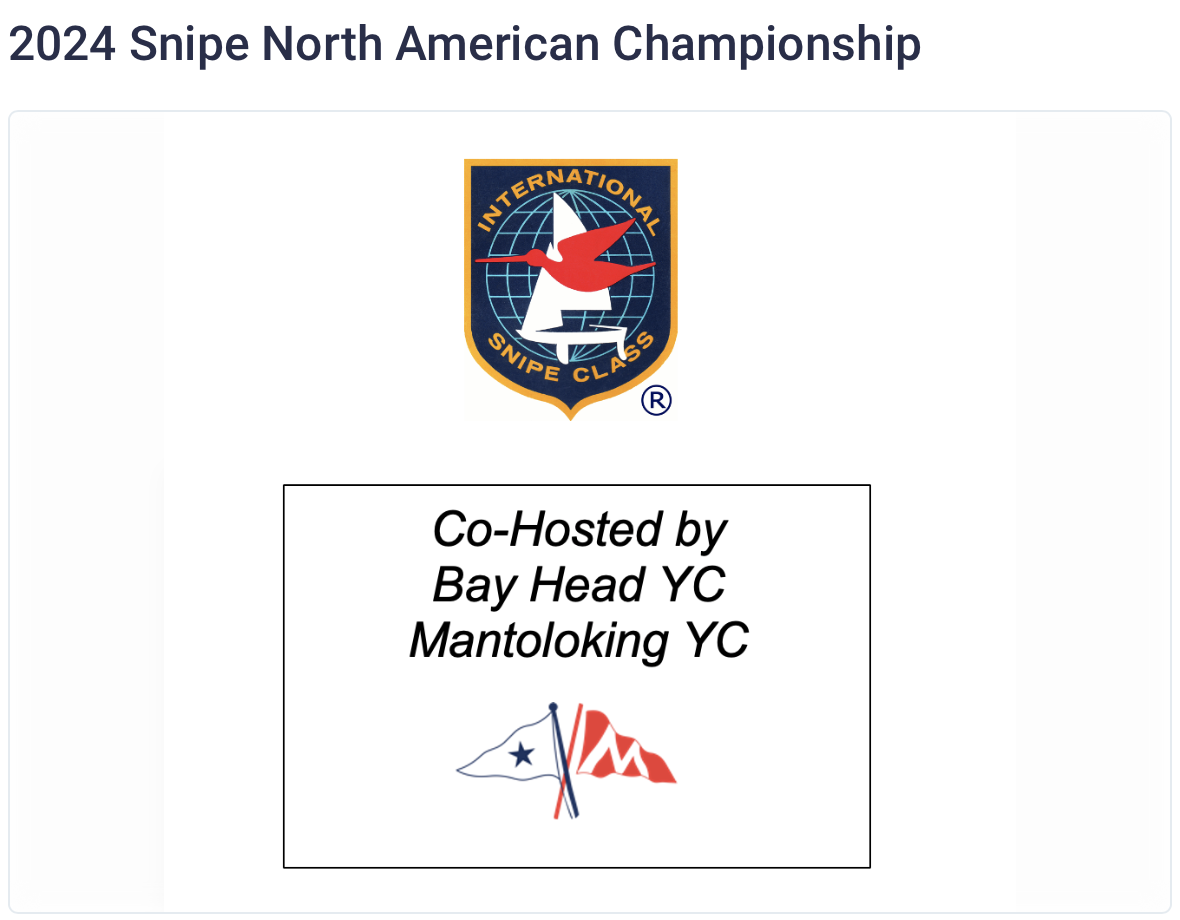
Snipe North American Championship – Sept 12-15 Entry still open to accept teams! Great event in a great venue! Co-hosted by Mantoloking & Bay Head YCs in New Jersey! 2…
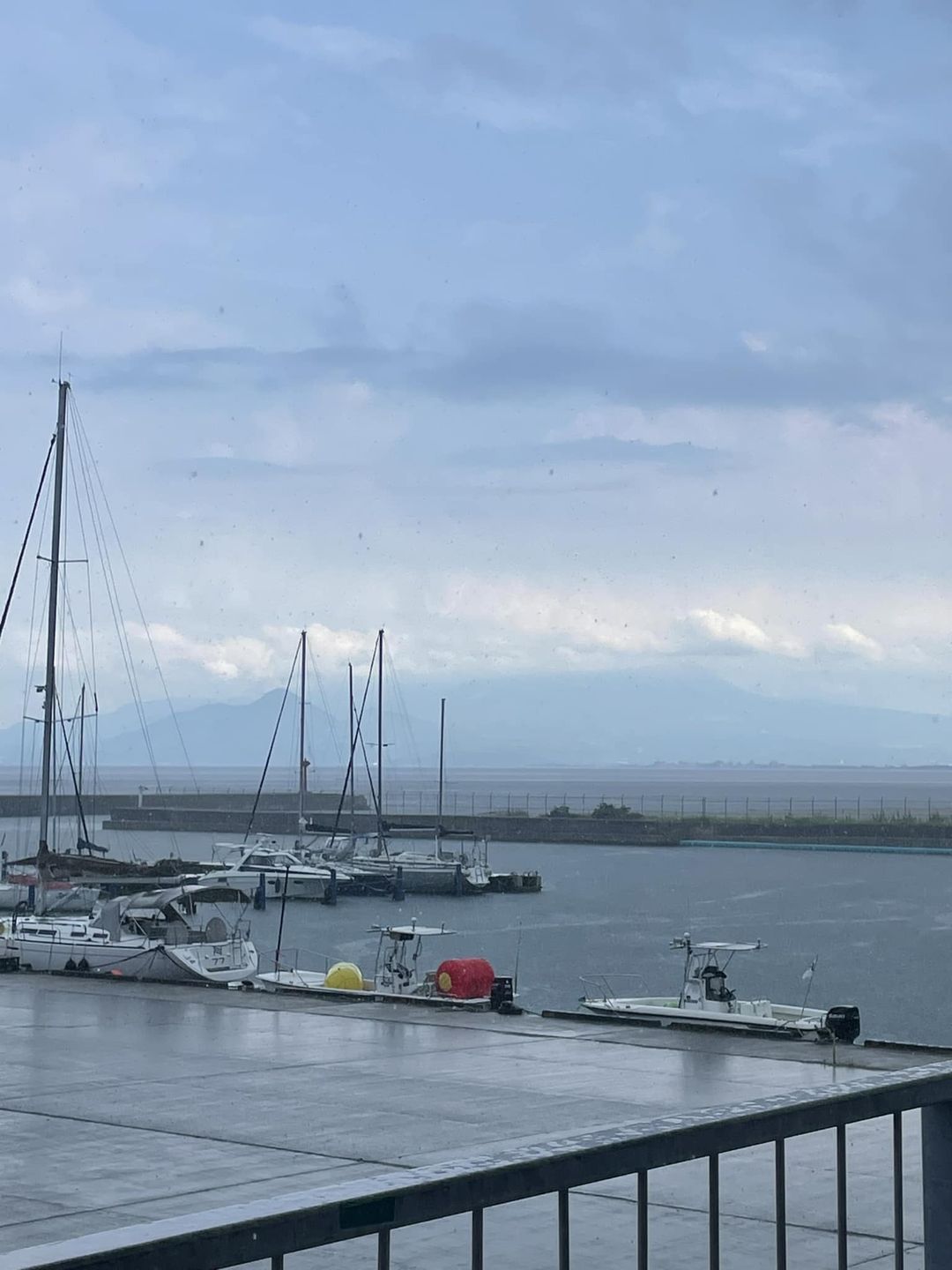
All Japan Nationals – Day 3
Sakaiminato, Japan, August 24, 2024…
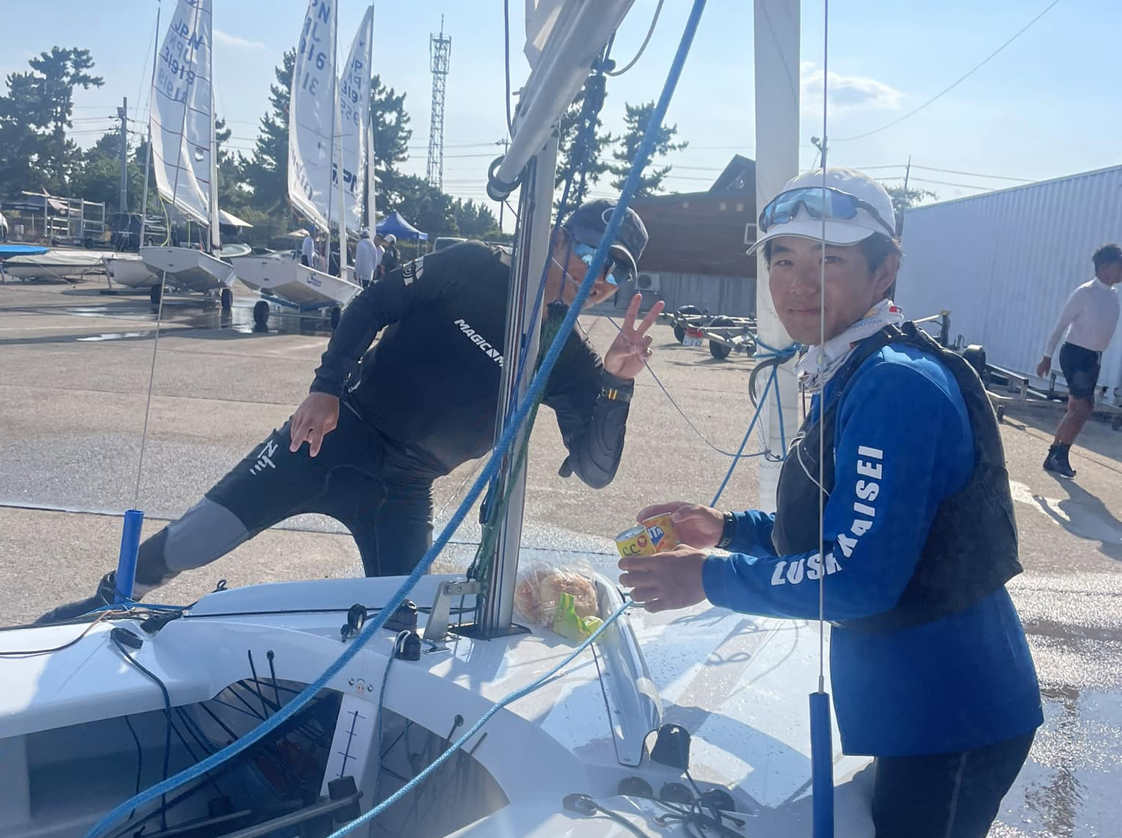
All Japan Nationals – Day 2
Sakaiminato, Japan, August 23, 2024…
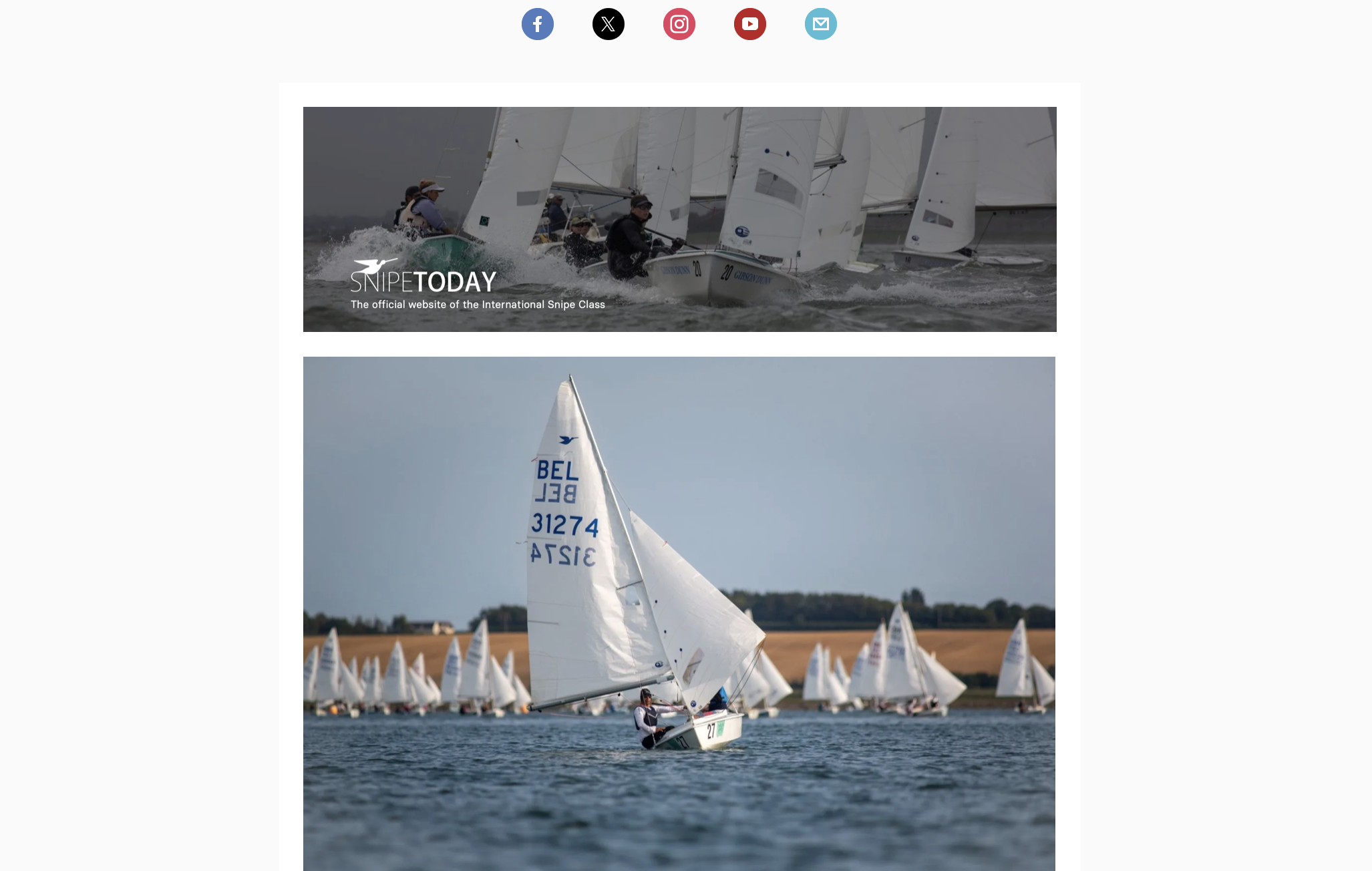
SnipeToday Stories This Week
Read this week’s SnipeToday Digest and then sign up to have it delivered directly to your inbox next week! Subscribe to list We…
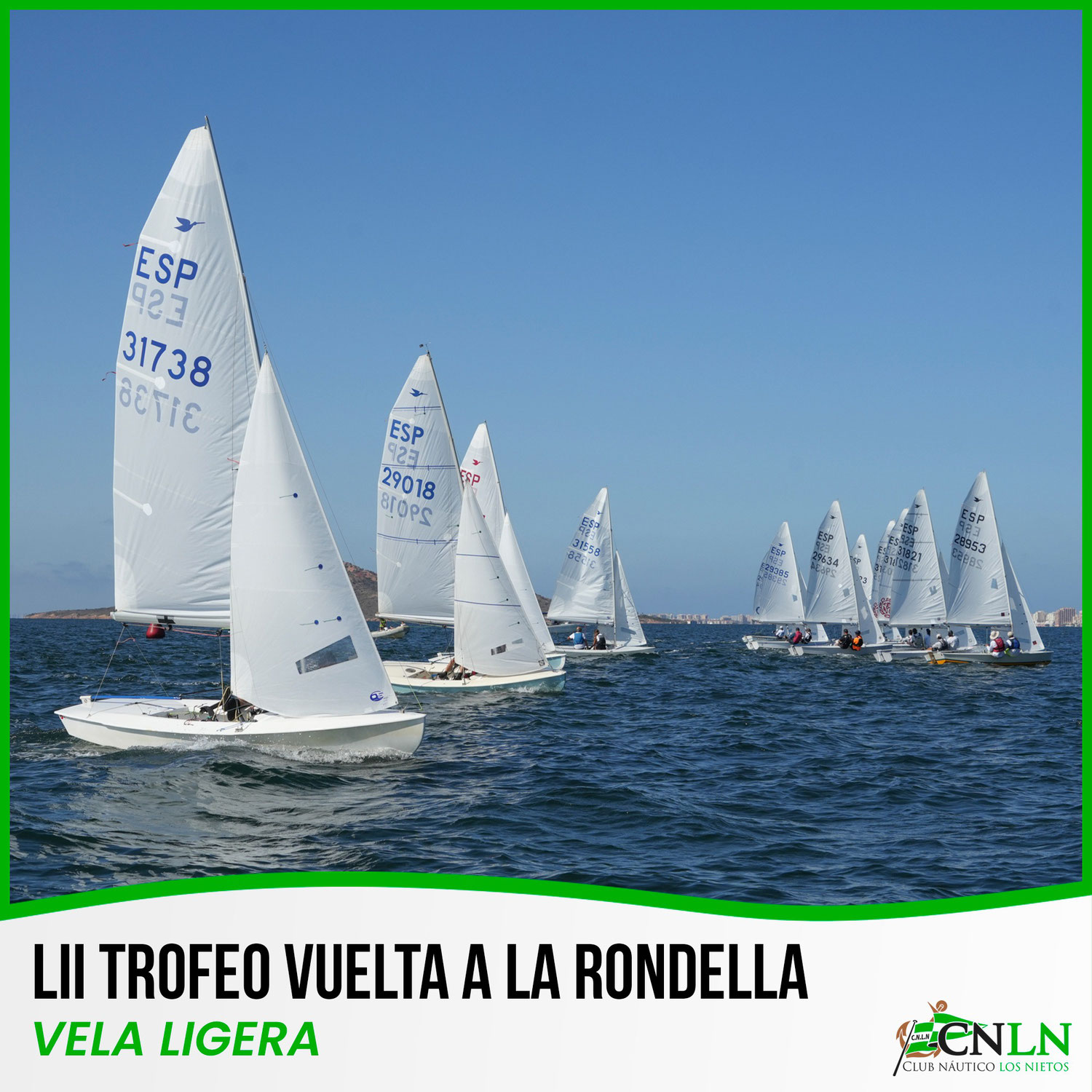
Gran Trofeo Club Náutico Los Nietos y Vuelta a la Rondella
Los Nietos, Spain, August 20, 2024…

La Caldera, Salta, Argentina, August 18, 2024…
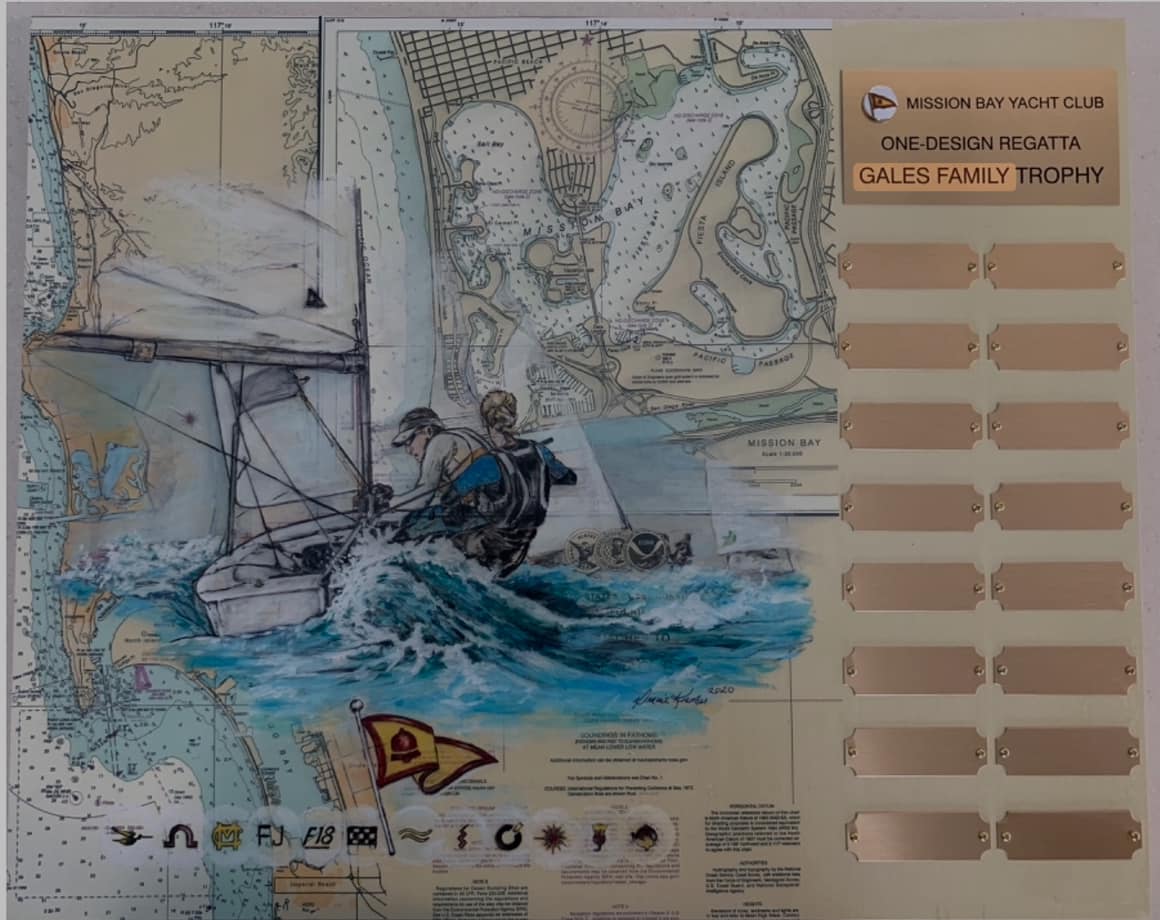
MBYC Gales Family One Design Regatta
Mission Bay, CA, USA, August 18, 2024. Final results after 6 races (1 discard): Blake Buckner & Charlotte Hinman, 14Owen Fretwell & Efe Derman, 15Asher Zittrer & Ciara Rodriguez-Horan, 18Robert…

Campionato Zonale Maccagno
Maccagno, Italy, August 15, 2024…

The Definitive Guide to Different Types of Dinghies
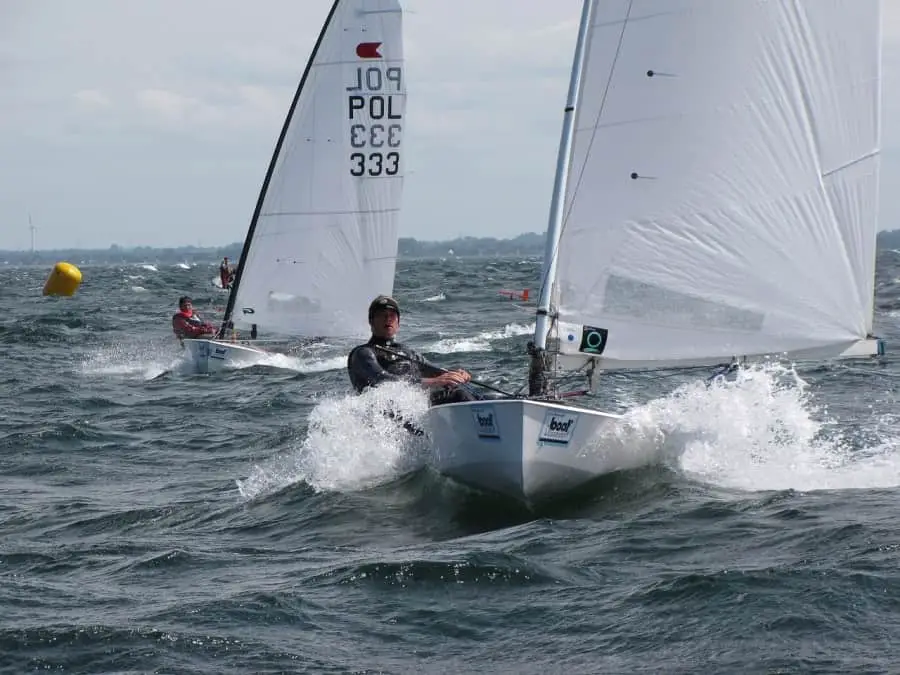
If you’ve ever gone out sailing or are just starting out, you’ve probably had the opportunity to get onto a dinghy to scoot yourself around. Dinghies can be extremely useful and fun at the same time whether you’re on a sailing dinghy or a power dinghy. The first time I ever got on a dinghy was a two person sailing dinghy, which is exactly when I started learning how to sail.
So what are the different types of dinghies? The different types of dinghies include sailing dinghies and power dinghies. Sailing dinghies have sails and do not have any type of motor attached to them and power dinghies have no sails and rely on motor power to move through the water.
When it comes to a dinghy, don’t let the size fool you. These little vessels can catch some serious speed and are central to many boating competitions around the world.
However, sailing dinghies and power dinghies usually serve different purposes, so let’s dive into the different types of dinghies to get a better understanding.
Sailing Dinghies
Sailing around on a dinghy is one of the more overlooked styles of sailing since everyone seems to want to get on a bigger yacht.
While there’s no arguing against the feeling of sailing on a larger vessel, dinghy sailing is a lot of fun which requires a good understanding of sailing fundamentals and an eye for precision.
High-Performance Dinghies
A high-performance sailing dinghy is as the name suggests; high-performance.
Its design is optimized to produce a fast and powerful sailing dinghy that can perform well in many environments and is often found in top regattas around the world. As you’ll soon realize, most sailing dinghies are constructed using fiberglass.
High-performance sailing dinghies usually have a spinnaker that can be attached to the sailboat so as to improve the speed of the boat under the right conditions.
Along with that, these sailing dinghies have what’s called a trapeze which is a wire that’s attached to the top of the mast and comes all the way down to the sailor’ harness.
This allows you to balance the force of the wind against the sail when the weather really kicks in.
Racing Dinghies
As you might have assumed already from the name, racing sailing dinghies are used primarily in racing environments.
While not too dissimilar to a high-performance sailing dinghy, there are some differences in terms of size, weight, and shape of the hull.
The design of a racing sailing dinghy is very important, but the skills of the crew on-board are usually what matters the most. Again, these types of sailing dinghies are made out of fiberglass.
The tactics implemented by the crew on a racing sailing dinghy are incredibly important. A racing sailing dinghy allows for crews to take advantage of the dinghy’s design so that they can tack and jibe much faster and more fluid than other dinghies.
On top of that, the hull of a racing sailing dinghy is quite flat which allows it to plane much easier resulting in a reduction of hull surface area touching the water.
Cruising Dinghies
If you’re not looking to compete with a racing or high-performance sailing dinghy, then you’re more likely to be sailing around in a cruising sailing dinghy. As the name suggests, they are made to cruise around the water and comfortably at that.
Designed for stability and safety in mind, cruising sailing dinghies are one of the most leisurely dinghies to take out on the water. Cruising dinghies are almost always made out of fiberglass.
As opposed to the previous sailing dinghies, cruising sailing dinghies generally have smaller sails and a more round hull .
As you might have guessed, the smaller the sails the less potential energy (and thus speed) your dinghy has.
The smaller sail also makes it easier to handle while cruising along. When it comes to the hull, a rounder hull also brings stability to the sailing dinghy as well as a very low chance of planing since there’s more contact between the hull and the water.
Cruiser-Racer Dinghies
If you have an inkling for racing but want to just cruise around comfortably from time to time, using a cruiser-racer sailing dinghy is an excellent choice.
These sailing dinghies are perfect for many different sailing environments and are my preferred type of sailing dinghy. It’s extremely common to find cruiser-racer dinghies made out of fiberglass.
Just like a cruising dinghy, the experience of being on a cruiser-racer dinghy is comfortable and provides good stability when out on the water.
However, if you want to turn up the notch and get it moving quickly, you can do just that since they have flatter hulls and generally larger sails. In the end, a cruiser-racer dinghy is right smack dab between a racing and cruising dinghy.
Classic Dinghies
If you’re looking for a classic experience on a sailing dinghy, then why not try out a… classic!
Classic dinghies can be found more often than you might think and can be fun to learn on when just starting out.
While you definitely won’t get the same performance as the other types of sailing dinghies, they’re quite comfortable and easy to use.
As opposed to most sailing dinghies, classic dinghies can be found to be made out of wood but usually they’re made from fiberglass.
Classic dinghies are unique in the sense that they have a cat sail and mast configuration . A cat, or “catboat”, has a single sail connected to a mast positioned at the bow of the sailboat.
Again, this makes them very easy to use and can be a great way to start learning how to sail. Also, I think they look rather nice, so beauty definitely plays a bit of a role in using a classic dinghy.
Power Dinghies
Before setting sail and exploring the beautiful waters of the world, you’ll want to make sure you know what kind of dinghy you have on-board.
As opposed to sailing dinghies, larger sailboats often times will have a power dinghy on-board in case you and your crew need to scoot around the local area quickly and easily.
Also, if you ever plan on anchoring out anywhere, it’s helpful to have a power dinghy to get to and from shore or to simply explore the surroundings.
The main differentiating factor between one power dinghy and another is the type of motor. More often than not, you’ll find dinghies with outboard motors, but that doesn’t encompass ever power dinghy out there.
Outboard Motor
As I just mentioned, the most common type of motor you’ll find on a power dinghy is an outboard motor.
Simply put, an outboard motor is attached on the backside of the power dinghy by means of a stern bracket and clamps or by bolts and nuts. Most outboard motor are powered by gasoline/petrol, however I’ve been on plenty of electrically powered dinghies when out fishing.
Outboard motors are popular because they’re relatively easy to maintain and can be replaced quickly if they crap out.
They also can be tilted up while still propelling your power dinghy forward, which allows you to cruise around shallow water without having your motor’s propellers hit the ground.
Your outboard motor can be either 2-stroke or 4-stroke. A 2-stroke motor requires mixing the gasoline/petrol with oil (most of the times this is automatic) and are generally less expensive to purchase.
A 4-stroke motor doesn’t require an oil-gasoline/petrol mix and is usually quieter, smoother, and more environmentally friendly, however more expensive to buy.
Inboard Motor
It’s not common that you’ll find a power dinghy with an inboard motor. However, you might see them if you’re on a power dinghy that holds 10 or more passengers and if the power dinghy is heavier in weight.
An inboard motor is fitted inside the power dinghy, so working on it or replacing it is a much larger hassle compared to an outboard motor.
Since power dinghies with inboard motors are quite heavy, you won’t find them on most sailboats. You will see them on shores where people are being taxied around as well as on-board much larger water vessels like megayachts.
Jet Drive Motor
Another type of dinghy motor is the jet drive motor, which, like the inboard motor, isn’t the most common type of motor to see on a power dinghy.
Similar to an inboard motor, a jet drive motor is generally built into the power dinghy making it more difficult to maintain and replace.
However, having a jet drive motor has its advantages and disadvantages. One advantage is one of safety being that, similar to a jet ski, a power dinghy with a jet drive motor doesn’t have propellers meaning nearby swimmers are much safer.
A major disadvantage to jet drive motor is that they can easily get items stuck inside of them, like plastic bags, jellyfish, and more, resulting in the motor shutting down.
Dinghy Materials
Apart from a power dinghies motor, another major differentiating factor when it comes to power dinghies is the material it’s made out of.
While the most common types of power dinghy you’ll find nowadays are inflatable, there are still plenty of solid material power dinghies out there.
If you’re on a power dinghy, there’s a good chance that it’s an inflatable power dinghy. There are several advantages of using an inflatable power dinghy especially that they’re easy to stow and less likely to damage vessels when they coming alongside.
A major disadvantage to using an inflatable power dinghy is that, unlike solid materials, they’re easier to puncture by reefs, sticks, and other sharp debris.
Fiberglass and Metal
Power dinghies that are made out of solid materials are often made out of either fiberglass or metal. While these types of materials aren’t as common nowadays for a power dinghy onboard a sailboat to have, they certainly aren’t rare.
The main advantage of having a power dinghy made out of fiberglass or metal is that it’s highly unlikely to be punctured compared to an inflatable power dinghy.
Some disadvantages include the fact that they can be heavy and they can scratch a sailboat’s hull when coming alongside.
Unless you’re a collector of classic dinghies, whether power or sailing, you won’t find many dinghies made out of wood nowadays.
Certainly, they exist but on much rarer occasions. The main advantage of a wood power dinghy is that it can look classy and antique-like while also not easily puncturable.
However, the downsides include those of the fiberglass/metal power dinghies as well as it being susceptible to leaks and having a greater maintenance cost compared to other power dinghies.
Get the very best sailing stuff straight to your inbox
Nomadic sailing.
At Nomadic Sailing, we're all about helping the community learn all there is to know about sailing. From learning how to sail to popular and lesser-known destinations to essential sailing gear and more.
Quick Links
Business address.
1200 Fourth Street #1141 Key West, FL 33040 United States
Copyright © 2024 Nomadic Sailing. All rights reserved. Nomadic Sailing is a participant in the Amazon Services LLC Associates Program, an affiliate advertising program designed to provide a means to earn fees by linking to Amazon.com and affiliated sites.

Introduction to Sailboat Racing [Rules and Classes Explained]
True, when you first witness a sailboat race, you might believe it’s too confusing and chaotic (it can be both). But, like with anything new, you may ease into it gradually. This is intended to allow you to take several actions at once.
Racing a sailboat is a lot of fun. It blends the excitement of sailing your own boat with the raw rivalry of trying to beat another boat of comparable size. Racing also teaches you boat handling and sail trim in a manner that cruising cannot: by comparing your speed and handling to those of other boats.
Let us jump into the article to learn more about sailboat racing.
![Introduction to Sailboat Racing [Rules and Classes Explained] 1 Sailing boat with two crew members participating in the sailboat racing](https://maritimepage.com/wp-content/uploads/2023/02/Sailboat-Racing-Rules-and-Classes-2-1024x683.webp)
Basic Insights Into Sailboat Racing
Sailboat racing may be separated into three parts: start , headwind , and tailwind . During a sailboat race, it is important to ensure that the beginning of the race must be strong. The start determines the overall outcome of the race and thus is considered very crucial for the race. It brings great advantage to the competitor and this is often very underrated.
As soon as the countdown is complete, it is necessary to make sure that the competitor has crossed the starting line effectively. Generally, warnings are given at 5mins and subsequently at 4mins and 1min .
Another very important aspect to consider is the path . The competitor must be able to determine a clear path to sail through and the direction of the race course must also be perceived correctly to ensure a favorable outcome. Free lanes enable the competitor with ideal angles to the wind with which they can easily navigate without having to go against disturbed wind or wind shadows from rival boats.
![Introduction to Sailboat Racing [Rules and Classes Explained] 2 Sailboat Racing Rules and Classes - Small sailboat racing](https://maritimepage.com/wp-content/uploads/2023/02/Sailboat-Racing-Rules-and-Classes-Small-sailboat-racing-1024x819.webp)
The Starting Line
Oftentimes, the first leg of the race will be upwind, after the starting line is crossed. At this point again, it is important to note that starting strong is crucial for an upwind race as more free lanes are accessible the further ahead the competitor is in the convoy.
The necessary determinants to be noted and kept in consideration throughout the race for effective upwind sailing strategies are the following factors: wind direction, wind speed, and rivals. But the last aspect can be tricky as everyone’s goal is ultimately to win.
Competitors need to base their choices for sailing downwind on the same findings, but with a few minor variations. Being at the forefront and tagged by rivals can be seen as a mode of suffering when the competitor must keep sailing in the wind shadows of all the boats behind. Here, there’s an advantage to be thought of if the competitor can position themselves at the rear. Any lane can be chosen at proper intervals to make up for the lost ground.
However, usually, down winds result in shorter wins and losses than up winds . This is because there is less transverse separation during down winds when compared to up winds.
![Introduction to Sailboat Racing [Rules and Classes Explained] 3 Sailboat Racing of the same class maneuvering near the start line](https://maritimepage.com/wp-content/uploads/2023/02/Sailboat-Racing-Rules-and-Classes-Dinghy-sailboat-racing-1024x683.webp)

Different Types of Sail Racing Classes
Sailboat racing can be done in different ways. Each race lasts for about 45min to 1hr and is conducted on a course marked by buoys mounted by the racing committee. One can also take part in “ distance races “. In this case, the “ natural ” surroundings will typically provide the race course.
The points of sail during the race depend on the predominant wind direction factors on the day of the race, which is the other major variation besides the length. While racing on the course, the race committee places the buoys in such a manner that the race course is adapted to the wind , this mostly enables the competitors to accurately identify which sail has to be deployed for the upcoming leg .
At the race course and during the distance races, the sailboats that participate are usually of various types and are commonly very diverse. As a result, the organizing committee frequently employs intricate “ handicap ” mechanisms to even out variations across boat types . The system is often country-based and it has been developed based on the most common types of boats in a country. The RC , ORC , and IRC systems are the most widely used on an international scale .
These systems compute a factor that should be multiplied by the exact time required to sail one nautical mile using complex formulas . They are based on the dimensions of the boat’s length, weight, sail size, types, and design of the boat along with the materials used .
To find the adjusted race time that can be used to compare with other competitors, this f actor is multiplied by the amount of time it took you to complete the race and the distance of the race .
It is very necessary to remember that these systems are not entirely accurate and they cannot be completely relied on. They can only be used to a certain extent for performance comparison . Hence it is advised that one must compete in races where the competing boats are similar to accurately assess the racing skills of the competitor.
![Introduction to Sailboat Racing [Rules and Classes Explained] 4 Sailboat Racing Rules and Classes](https://maritimepage.com/wp-content/uploads/2023/02/Sailboat-Racing-Rules-and-Classes-6-1024x683.webp)
Main Rules in Sailboat Racing
These races are administered and authorized by the International Racing Rules of Sailing . It lays down rules and safety measures to sail safely across the race course along with the entire fleet, whose goal is to sail successfully during the race as well.
A rulebook is laid down with fundamental rules providing explanations and specimens about ensuring how to maintain and regulate according to the laws during a variety of circumstances that can arise between competing sailboats during the course of the race.
The most fundamental rule is that vessels with their starboard side windward must give way to vessels with their port side windward . This implies that the port-tack boat must either tack or bear away to pass behind the stern of the starboard-tack boat when two boats on opposite tacks come together . The leeward boat always has the right of way over the windward boat when there are two boats on the same tack.
![Introduction to Sailboat Racing [Rules and Classes Explained] 5 YouTube player](https://i.ytimg.com/vi/y_Au4vEg-Aw/maxresdefault.jpg)
Although this is the case, it is essential to note that the boat with the right of way must always ensure to leave other sailboats adequate space and time to avoid collision and accidents . While trying to maintain contact with other competitors, one must be very safe and secure as a significant level of rule interpretation can be enforced.
Violation of any rule can cause you to self-forfeit from the race . Hence it is advised to make amends and surrender upon having committed a conscious foul. Most admitted fouls are looked over following a penalty turn of 360 degrees or 720 degrees . Sailing instructions can be seen as a guide in all circumstances to find more detailed information about the same. A few rules can also be helpful when it comes to knowing what to be worn during the race apart from obvious determinants like the weather and climate conditions.
![Introduction to Sailboat Racing [Rules and Classes Explained] 6 Sailboat Racing Rules and Classes](https://maritimepage.com/wp-content/uploads/2023/02/Sailboat-Racing-Rules-and-Classes-4-1024x678.webp)
Main Equipment Used In Sailboat Racing
The sport of sailing is generally very physically taxing and hence requires e xtraordinary energy throughout the course of the race especially while rounding marks and sailing downwind.
When the atmospheric temperature falls due to wind-chill effects , it makes much colder winds frequently. In such circumstances, making use of a windproof outer layer will guard against the wind chill and this material is also breathable . Such measures must be ensured to avoid being cold and clammy. Wearing boots can also ensure to keep yourself warm and comfortable.
Looking into the technical aspects , sailboats need to ensure they are fully equipped with communication and navigation devices such as VHF, GPS, Sat Phones , and so on.
![Introduction to Sailboat Racing [Rules and Classes Explained] 7 Sailboat Racing - Volvo Ocean Racing Sailboat](https://maritimepage.com/wp-content/uploads/2023/02/Sailboat-Racing-Volvo-Ocean-Racing-Sailboat-1024x682.webp)
Different Types Of Sailboat Races
Sailboat racing is a diverse and dynamic sport that encompasses a wide range of different race types , each with its own unique rules, tactics, and strategies . Understanding the different types of sailboat races is crucial for sailors looking to compete at a high level and succeed in this exciting sport.
One of the most common types of sailboat racing is fleet racing, which involves a large number of sailboats competing in a single race. In fleet racing, the sailboats start together and sail a predetermined course, with the first boat to cross the finish line being declared the winner. Fleet racing often requires a high degree of tactical maneuvering, as sailors must navigate around other boats and adjust their tactics to account for wind shifts and other factors.
Another popular type of sailboat racing is match racing, which involves two sailboats competing head-to-head in a series of races. In match racing, the emphasis is on tactical maneuvering and outsmarting your opponent, rather than simply being the fastest boat on the course. Match racing typically involves a complex set of rules and regulations governing how boats can interact with each other on the course, and sailors must be highly skilled at reading wind shifts, controlling their boats, and outmaneuvering their opponents.
![Introduction to Sailboat Racing [Rules and Classes Explained] 8 sailboats with black sails](https://maritimepage.com/wp-content/uploads/2023/06/sailboats-with-black-sails.jpg)
Team racing is another type of sailboat racing that involves multiple sailboats competing against each other in a team format. In team racing, each team consists of multiple boats, and the team with the best overall performance across all of its boats is declared the winner. Team racing often requires a high degree of coordination and strategy, as sailors must work together to achieve a common goal and coordinate their tactics to maximize their chances of success.
In addition to these main types of sailboat racing, there are also a variety of specialized race types that are popular in different parts of the world . For example, ocean racing involves sailing across the open ocean over long distances and requires a high degree of skill and endurance. Inshore racing , on the other hand, takes place in protected bays and harbors and often involves short, fast races with frequent wind shifts and other challenges.
Regardless of the type of sailboat racing, one thing remains constant: the need for skilled and experienced sailors who can navigate their boats through a wide range of conditions and challenges. Whether you’re a seasoned veteran or a beginner just getting started, mastering the different types of sailboat racing can be a highly rewarding and exhilarating experience, and can lead to a lifetime of excitement and adventure on the water.
![Introduction to Sailboat Racing [Rules and Classes Explained] 9 Sailboat Racing Rules and Classes](https://maritimepage.com/wp-content/uploads/2023/02/Sailboat-Racing-Rules-and-Classes-5-1024x683.webp)
Classes Of Sailboats Commonly Used In Racing
Sailboat racing is a highly competitive and dynamic sport that encompasses a wide range of different classes of sailboats, each with its own unique characteristics, strengths, and weaknesses. Understanding the different classes of sailboats used in racing is crucial for sailors looking to compete at a high level and succeed in this exciting sport.
One of the most common classes of sailboats used in racing is the dinghy , which is a small, lightweight boat typically sailed by one or two people. Dinghies are highly maneuverable and responsive and can be sailed in a wide range of conditions, from light winds to strong breezes. Popular dinghy classes include the Laser , the 420 , and the Optimist , each of which has its own unique rules and specifications.
Keelboats are another popular class of sailboats used in racing, and are typically larger and heavier than dinghies, with a fixed keel that helps to provide stability and control. Keelboats come in a wide range of sizes and designs, from small one-design boats like the J/24 to larger performance-oriented boats like the TP52. Keelboats are often sailed by a crew of several people and require a high degree of coordination and teamwork to sail effectively.
Multihulls are another popular class of sailboats used in racing and are characterized by their multiple hulls providing greater speed and stability than traditional monohull sailboats. Multihulls come in a variety of different designs and sizes, from small catamarans to large trimarans , and are typically sailed by a crew of several people. Multihulls can be highly competitive and exciting to sail, but also require a high degree of skill and experience to handle effectively.
In addition to these main classes of sailboats, there are also a variety of specialized classes that are popular in different parts of the world. For example, in Australia and New Zealand, the 18-foot skiff is a highly competitive and popular class of sailboats, characterized by its large sail area and high speed. In Europe, the Dragon is a classic one-design keelboat that has been popular for decades and is known for its elegant design and excellent performance.
Regardless of the specific class of sailboats used in racing, one thing remains constant : the need for skilled and experienced sailors who can navigate their boats through a wide range of conditions and challenges . Whether you’re racing a dinghy, a keelboat, a multihull, or some other type of sailboat, mastering the unique characteristics and challenges of your boat is key to achieving success on the water.
To become a successful sailboat racer , it’s important to not only master the technical skills needed to sail your boat effectively , but also to develop a deep understanding of the rules, tactics, and strategies that govern sailboat racing . By immersing yourself in the world of sailboat racing and learning from experienced sailors, you can build the skills and knowledge needed to succeed in this exciting and challenging sport.
![Introduction to Sailboat Racing [Rules and Classes Explained] 10 YouTube player](https://i.ytimg.com/vi/sAxD7w0lDhA/maxresdefault.jpg)
In conclusion, participating in a race can be very enjoyable in both cases. The first case is where someone is learning the art of sailing or like in the second case where one could be trying to gain some prior expertise on the sea.
If winning the race is one’s main aim then the key thing to remember is to make sure that you tack at the right moments. To trim the sails to completely catch the wind and last but not least, to communicate well with the rest of the crew.
- Recent Posts
- The Role of Cargo Ships in Global Trade – August 22, 2024
- Report: Yang Ming’s YM Mobility Explosion at Ningbo-Zhoushan Port – August 9, 2024
- Understanding Drillships: Types, Key Features and Advancements – August 1, 2024
About the author
I worked as an officer in the deck department on various types of vessels, including oil and chemical tankers, LPG carriers, and even reefer and TSHD in the early years. Currently employed as Marine Surveyor carrying cargo, draft, bunker, and warranty survey.
Latest posts

The Role of Cargo Ships in Global Trade
Contents show Volume of Goods Transported by Sea Key Global Trade Routes Economic Impact of Maritime Shipping Types of Cargo Commonly Transported Environmental Considerations Conclusion Cargo ships are the lifeline […]

What Are AGVs? Automation Becoming Increasingly Common in Seaports
What are AGVs? Automated guided vehicles can minimize the troubles of manual operations and enhance seaport operations.
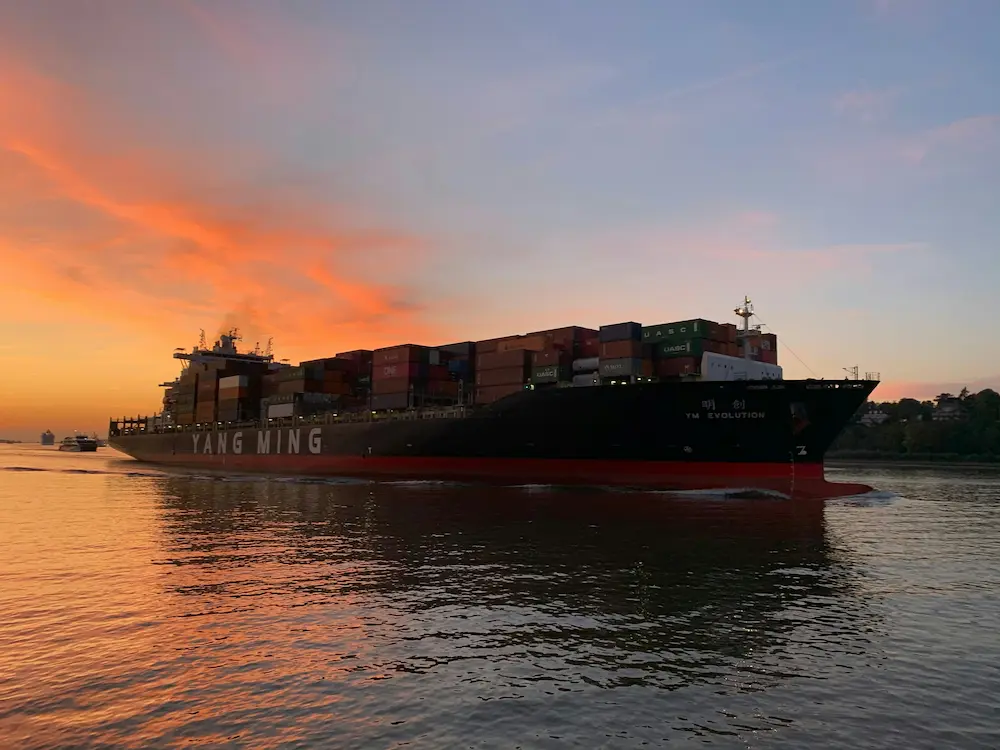
Report: Yang Ming’s YM Mobility Explosion at Ningbo-Zhoushan Port
A massive explosion occurred on the container ship YM Mobility while it was berthed at the Ningbo-Zhoushan Port in China

The 5 Best Sailboats For Beginners

Last Updated by
Daniel Wade
December 27, 2023
Sailing is a fun activity for people of all experience levels. In fact, learning to sail a basic boat is relatively easy—in the right environment, you can start cruising with minimal experience.
However, the idea of a beginner commanding a 55-foot ketch in the middle of the Atlantic Ocean is a bit ridiculous. Even though virtually everyone can sail, beginners should learn the basics in a controlled environment—and on the correct boat.
Boat size doesn’t necessarily affect its beginner-friendliness, because sailors need to take into account factors such as rig simplicity and handling characteristics.
Many beginners make the mistake of picking the wrong boat to begin with, which can lead to frustration and turn them off of sailing forever.
To mitigate these issues, this article will cover the best sailboats for beginners —so you can get on the water and start sailing safely and comfortably.
Table of contents
Best Rigs for Beginners
There are many types of sailboat rigging , and some are more beginner-friendly than others. Unfortunately, some of the most aesthetically pleasing rigs are also the most complicated.
Eventually, sailors can acquire enough skill to master complex rigs, but it’s best to start simple.
Arguably, one of the simplest sailing rigs is the Lateen Rig. This rig consists of a mast, boom, and spar, along with a single halyard and mainsheet. With only two ropes in its simplest configuration, the Lateen Rig makes an excellent starter sailboat, and it will be featured on this list.
For larger boats, the Bermuda Sloop rig is an excellent choice. This rig is quite common and includes a jib for a larger sail plan.
For those who desire a slightly more robust (but single sail) layout, the gaff-rigged catboat is also an excellent choice. This versatile craft (and rig) has a large and relatively simple single sail, which is easier to handle than multiple sails.
Top Five Sailboats for Beginners
Now, we’ll go over the top five sailboats for beginners . These boats will descend in order from smallest to largest, but not by the level of experience needed.
Remember, just because you’re new to sailing doesn’t mean you have to settle for a boat that’s too small. Beginners can handle larger boats with some training, and some are easier to handle than their smaller counterparts.
The following boats were chosen because of their handling characteristics, low cost-of-ownership, and simplicity, as all of these factors are important for choosing the best beginner sailboat.
5) Sailing Dinghy
The sailing dinghy is the quintessential starter sailboat. These tiny, lightweight, popular, and highly affordable little craft is easy to operate and relatively difficult to capsize. The popular Optimist Sailing Dinghy, while designed for children up to the age of about 15, can be used (sometimes hilariously) by adults as well. An Optimist-style dingy is a great option for beginners over the age of 15, as boats of this style can be found in a variety of sizes. The sailing dinghy is a very popular youth racing sailboat, especially in the United States and the United Kingdom. While it’s not particularly fast, this little boat has wonderful handling characteristics and is relatively difficult to capsize. This open-cockpit boat uses a centerboard and detachable tiller and can be beached or carried atop a car without much hassle. The mast is removable, and all parts are easily stowed. Overall, the Optimist and its copycats are a remarkable little craft, equally useful as a tender for a larger boat or a standalone beginner sailboat.
Dinghy rigs vary between builders, but many use the simple Spirit Rig. The rig consists of a single sail and mainsheet, along with one mast, boom, and spar. The leech is stiffened by battens, and ties along the luff secure it all to the mast. Hoisting and securing the rig is easy, and lines are secured to the boat by a cleat. This simple rig has plenty of sail area for most places, and sailors can secure the mainsheet to a block or simply hold it in their hands.
The price of sailing dinghies can vary widely depending on multiple factors. Professionally-made sailing dinghies start around $3,500 new, and plywood kits are available for around $1,000 to $2,000. Used dinghies (including Optimist sailing dinghies) can be found on Craigslist for as low as a few hundred dollars.
{{boat-info="/boats/vanguard-sunfish"}}
The Sunfish is a brilliant little sailboat, and a very fast boat indeed. This little racing dinghy, while only 13 feet in length, can be an enormous amount of fun for beginners and experienced sailors alike. The best way to describe the handling of a Sunfish is, ‘tender,’ though it’s not difficult to master this little boat. For its size, the Sunfish has a relatively large sail area and a very shallow draft. This boat has a small cockpit and can be controlled easily by a single person. The large sail plan of the Lateen-Rigged Sunfish makes for excellent performance in light winds and amazing speed on windy days. The Sunfish is a lightweight fiberglass boat with a simple rig and is a great step-up from a sailing dinghy. It’s possible to learn how to sail on this boat, but every sailor who’s spent time on a Sunfish will probably recommend bringing a towel. The boat is relatively easy to capsize for beginners and it heels aggressively, but these characteristics can teach sailors some important lessons. The heeling characteristics of the Sunfish can help beginners get accustomed to the feeling and help them understand the limits of a sailboat and how to avoid capsizing.
The Sunfish features a Lateen Rig, which has some shared characteristics with the simple Spirit Rig. The Lateen Rig has a single spar, mast, and boom, and is easy to set up and dismantle. The mast is removable as well, making stowing and transportation relatively easy. The large sail plan of the Sunfish makes it ideal for lakes and other areas where the wind is sporadic or very low, and the boat can be safely handled in many conditions. The boat is great for racing and learning and is also available in a Bermuda rig. The Sunfish is recognizable by the distinctive fish logo in the top corner of the sail, and the classic rainbow sails striping.
The Sunfish is still commercially manufactured. You can purchase one new from the factory for around $5,000 today, and options are available to make the boat your own. While the boat is designed to be sailed by a single person, two adults can purchase this boat and use it together comfortably. Used Sunfish prices vary, but a fully-outfitted boat in good condition can cost upwards of $1,000. They hold their value well, and they’re a great choice for beginners.
{{boat-info="/boats/vanguard-laser"}}
The Laser is considered by many to be the Sunfish’s main competitor. The two boats are the same length (13 feet 9 inches) and share many of the same handling characteristics. However, the boats do have some notable differences. Many people consider the Laser to be a step-up from the Sunfish in difficulty, as the boat handles much more like a racer. The Laser has been used in the Olympics for racing. The laser is small and simple enough for beginners but requires skill to operate. Beginners can learn a lot from sailing a Laser and have an enormous amount of fun in the process. This fast little boat is simple and easy to set up but handles like a racecar. If you’re a beginner on a laser, you’ll probably capsize at some point—which isn’t always a problem if you’re in a controlled environment, as the boat can be righted easily.
The laser is a Cat Rigged boat. This means it has only one mainsail and no headsails. The simple rig has a mast and a boom and is very easy to set up. The sail area of the laser is relatively large and designed for speed in high winds. The rig combined with the overall design of the sailboat makes it handle tenderly, which may be off-putting to some beginners. Regardless, it’s still a blast to sail for beginners with some experience.
New Laser sailboats start around $6,000 which is slightly more than the Sunfish. This simple centerboard cruiser is constructed as a race boat, which can explain some of the price increase. Used Laser sailboats are available on the market, though usually not as common as the Sunfish. Used Laser prices vary widely.
2) Gaff-Rigged Catboat
The gaff-rigged catboat isn’t a brand of boat—it’s a style of a sailboat that was once a popular workboat on the New England coast. This boat, which has only one mainsail and no headsails, is available in a wide range of designs. Catboats are famous for their handling and power and make a great sailboat for beginners. These vessels are available with centerboards, keels, cabins, and in open designs. Most catboats range from 15 to 19-feet long and can be built from wood or fiberglass. Catboats are easy to handle, and one who learns on a small catboat can easily transition to a larger one. Besides being one of the most easily recognizable sailboats, catboats are also some of the most versatile. A catboat can be just as suitable for lake cruising as it is for coastal waters.
The most common type of catboat rig is the Gaff Rig. This classic and robust rig is more complex than the simple Spirit and Lateen rig, but it’s more suitable for a ‘proper ship.’ The Gaff Rig can provide similar power as an equivalent Bermuda Rig, with much more elegance and a shorter mast. Many sailors prefer the classic Gaff Rig for its handling characteristics and durability.
It’s impossible to specify the price of catboats because they vary so much in design and size. New catboats (between 15 and 25-feet) can be purchased for less than $20,000, and used boats are numerous and varied. Cabin catboats tend to cost more, especially new—some run for more than $50,000 with a high level of amenities, including a head and galley. Numerous catboat plans are available online, and sailors report constructing them (usually of plywood) for just a few thousand dollars.
1) West Wight Potter 19
{{boat-info="/boats/west-wight-potter-19"}}
The West Wight Potter 19 is a fiberglass sailboat designed for safety, easy handling, and beginner-friendliness. This 19-foot trailer-sailor features a cabin with a vee-berth, a simple rig, and a retractable keel. The West Wight Potter 19 could potentially be the best cabin sailboat for beginners, and certainly one of the safest—the West Wight Potter 19, according to the manufacturer, is quite literally unsinkable. The hull is filled with buoyant materials, allowing the boat to be flooded and remain afloat. However, unsinkability isn’t the only characteristic of this boat that makes it ideal for beginners. The rig is simple and easy to set up, and the handling characteristics are excellent. The boat is not prone to aggressive heeling and handles confidently in a variety of conditions. While one generally wouldn’t consider it to be a blue-water cruiser, it’s still extremely capable—one sailor even sailed this vessel from California to Hawaii , which is over 2,000 nautical miles. The theoretical hull speed of this boat is around 5.4 knots, but it actually has a tendency to plane and achieve higher speeds. It’s a flat-bottomed cruiser, making it easy to beach and transport with its retractable keel and removable rudder. The West Wight Potter 19 is a great introduction to large sailboats and carries amenities normally reserved for boats at least 1/3 larger.
The West Wight Potter 19 is a Bermuda-Rigged sloop. The sail plan is sufficiently large to propel the boat in a variety of conditions, but not so large that it overpowers the boat. Sailors can single-hand the boat with ease, and set up and takedown are easy and require no special tools. The boat handles well in a variety of conditions and is well-known for its superior stability. The rig comes apart easily and can be stowed and trailered by one person.
The West Wight Potter 19 has been produced and sold commercially since the 1970s, and the used market has plenty of boats available, generally starting around $5,000. New West Wight Potter 19 sailboats are remarkably affordable compared to other boats with comparable characteristics. The West Wight Potter 19 is manufactured by International Marine in California. New sailboats start at just shy of $25,000. Owners can add an enormous range of extra features to their boats, including a hull-strengthening ‘blue water’ package, a stove, a head, electrical power, spare parts, and much more. The boats are highly customizable and can be outfitted for weekender sailing or long-term liveaboard cruising.
How to Pick a Sailboat
Picking a sailboat for beginners doesn’t have to be difficult. Before deciding on a boat, consider your experience level and location.
If you only have access to rough ocean, it may not be the best idea to get an open dinghy.
If you live near a lake, a Sunfish could be a great way to start.
Also, consider your budget. If you’re looking for a $50 sailboat, you can probably find one, but it won’t be ideal.
If you have just a few thousand dollars to spend, you can set yourself up nicely with a little research .
Also, consider what you want to do with the sailboat. Recreation, fishing , cruising , and exploration are options, and require different kinds of boats.
Whichever you end up choosing, make sure you try it out and can sail it comfortably.
Related Articles
How To Buy A Beginner Sailboat
Sail Maintenance For Beginners
Can a Novice Sail Around the World?
I've personally had thousands of questions about sailing and sailboats over the years. As I learn and experience sailing, and the community, I share the answers that work and make sense to me, here on Life of Sailing.
by this author
Best Sailboats
Most Recent

What Does "Sailing By The Lee" Mean?
October 3, 2023

The Best Sailing Schools And Programs: Reviews & Ratings
September 26, 2023
Important Legal Info
Lifeofsailing.com is a participant in the Amazon Services LLC Associates Program, an affiliate advertising program designed to provide a means for sites to earn advertising fees by advertising and linking to Amazon. This site also participates in other affiliate programs and is compensated for referring traffic and business to these companies.
Similar Posts

Affordable Sailboats You Can Build at Home
September 13, 2023

Best Small Sailboats With Standing Headroom
December 28, 2023

Best Bluewater Sailboats Under $50K
Popular posts.

Best Liveaboard Catamaran Sailboats

Elizabeth O'Malley
June 15, 2022

4 Best Electric Outboard Motors

How Long Did It Take The Vikings To Sail To England?

10 Best Sailboat Brands (And Why)
December 20, 2023

7 Best Places To Liveaboard A Sailboat
Get the best sailing content.
Top Rated Posts
Lifeofsailing.com is a participant in the Amazon Services LLC Associates Program, an affiliate advertising program designed to provide a means for sites to earn advertising fees by advertising and linking to Amazon. This site also participates in other affiliate programs and is compensated for referring traffic and business to these companies. (866) 342-SAIL
© 2024 Life of Sailing Email: [email protected] Address: 11816 Inwood Rd #3024 Dallas, TX 75244 Disclaimer Privacy Policy
- Paddle Board

A Guide to Dinghy Boats
Are you looking for an affordable boat for your fishing trips or watersports? The dinghy offers you the best options for a low-cost, versatile watercraft. There are several dinghy designs to suit any watersports activity.
Typically, dinghies are the best choice for watersports like skiing and diving. However, some models are good for cruising or light sailing, with options for motors or sails. A dinghy can range in size, but most of them are suitable for carrying two to six people.
Dinghies are available in models suiting use in freshwater or saltwater, with inflatables, solid boats, and more options. Is a dinghy the right choice for your boat? Let’s unpack everything you need to know about these watercraft.
What Is a Dinghy Boat?
A dinghy is a small boat, usually and inflatable, and most models are around five to ten feet long. A dinghy is easy to transport, and it offers versatile utility for fishing and watersports. You also have options for motors, sales, or you can use oars to propel the boat.
Dinghies can feature fiberglass construction, or they may use inflatable pontoons, similar to a pontoon boat. The inflatable models typically feature design and construction with Hypalon or PVC. These polymers provide UV resistance, tough resistance against punctures, and easy repairs.
The sides on inflatables also act as seats, allowing fishing directly from all sides of the boat. Dinghies are not really built for speed; they usually come with low-powered trolling motors with a 3-hp to 5-hp output. However, they are ideal for moving through estuaries and lakes, allowing for silent movement so you don’t disturb the fish.
What are the best beginner sailing dinghies?
If you’re just getting into sailing, there are several dinghy options for enjoying your time out on the water. Whether you want to sail solo or with a friend, there is a boat for you.
Training Sailing Dinghies
These models are easy to master, giving beginners the chance to master the complexities of sailboats. They are simple to operate, safe, and offer you the best option for learning to master sailing techniques.
Doublehanded Sailing Dinghies
These models cater to two passengers for handling the sail and rigging. They are great for learners, allowing them to take an experienced sailor out on the water to learn the ropes.
Singlehanded Sailing Dinghies
These models have a design for one person. Typically, they are smaller boats, and you’ll already have to know how to sail. However, they are easy to master, and spending time out on the water will familiarize you with the aspects of sailboats.
These dinghies feature double or triple hulls. They are typically the best choice for racing, and they offer excellent stability in all water conditions.
Different Types of Dinghy Models
As mentioned, there are several models of dinghies for different watersports activities. Here are the most common options; we categorized them into sailing dinghies and inflatable dinghies.
Sailing Dinghies
A sailing dinghy is a small sailboat with no fixed keel and a shallow draft. These models are ideal for sailing in lagoons, estuaries, and lakes, navigating shallow waters. The sailing dinghy typically features a fiberglass design, with an open-plan seating area and a mast. These boats usually accommodate anywhere from one to five passengers.

High-Performance Dinghies
High-performance sailing dinghies are another sail-based model that’s ideal for racing. They are fast and cut through the water with ease. You get excellent maneuverability on the water with a low-profile design and an open-plan deck with a mast. The Fireball, International 505, and Thistle are a few examples of leading racing and high-performance dinghies.
Cruising Dinghies
A cruising dinghy is another sail-based model that’s a great choice for cruising out in calm ocean conditions or inland water bodies. They are a recreational vessel equipped with sails and rudders, and you have more passenger capacity than the other sailing models. As a result, they are the ideal choice for family’s that enjoy the sailing lifestyle.
Cruiser-Racer Dinghies
These models are hybrids that come with a focus on performance and stability. They have the ability to race or to cruise, providing excellent stability in the water. They are a great choice for someone that wants to start sailing competitively, and they also work for fun recreational sailing days on the lake with the family. The GP14 is an example of a cruiser-racer offering high-performance standards and stable cruising.
Classic Dinghies
These boats had an original design featuring wood finishes using materials like plywood and cedar. However, modern dinghies feature fiberglass construction. The classic dinghy sailboat focuses on versatility over sailing performance. The Minto is a great example of a classic dinghy.
Inflatable Dinghies
Inflatables are gaining in popularity thanks to the affordable price tag and versatility offered by the boat. Inflatables are easy to carry, and some might even fit on the back of a truck. Inflatables have side pontoons, and many of them are suitable for diving activities or spearfishing. These dinghies usually feature low-powered trolling motors; they don’t have a design for speed.
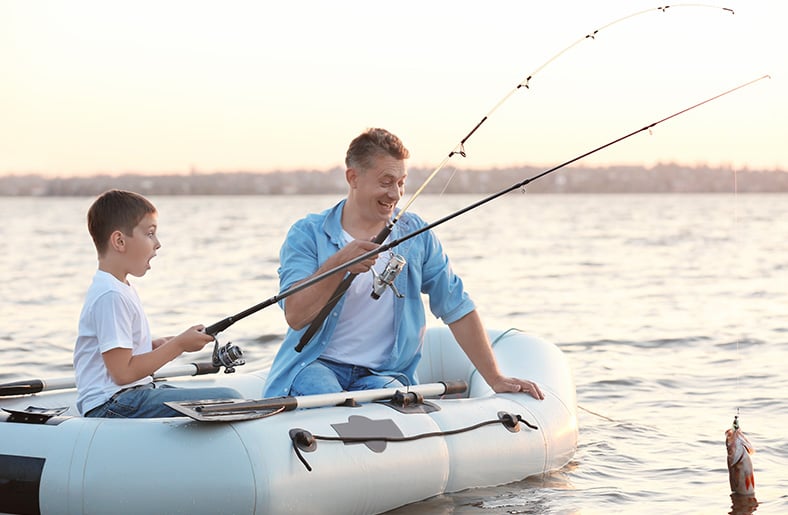
Features and Benefits of Dinghy Boat
Dinghies are versatile and affordable. There are plenty of benefits for choosing this boat beyond just the savings you make over other models.
The dinghy is one of the few boats left that offer a sailing configuration. If you’re into boating on lakes or thinking about sailing competitively, the dinghy is the best choice. Any of the sailing models listed above are a great choice. Pick the boat that offers you the best utility for your sailing needs.
Minimal Noise
Most dinghies are sailing options, so you don’t have to worry about gas fumes from the motor or noise. They offer a serene sailing experience on inland waters. Inflatable models may use a trolling engine for moving through calm, shallow waters when fishing. The low noise and churn produced by the motors won’t scare off the fish. You also have options for poling and oars for moving around without engines.
Trailerable
Dinghies are compact boats with sailing and inflatable models offering you easy trailering. Some of the smaller inflatables can fit in the back of a panel van or on the load bed of your single-cab truck. They offer you easy transport between lakes and estuaries, with a lightweight design that’s easy to launch and trailer.
Options for Inflatables or Fiberglass
As mentioned, the dinghy comes in sailing and inflatable options. Some fiberglass models also feature a wood finish on the deck for an added aesthetic that looks like a classic dinghy.
Ideal as an Excursion Boat for Yachts
Many superyachts use inflatable dinghies allowing the passengers to reach the shore. Yachts can’t enter shallow water, and the dinghy makes the ideal transfer boat for reaching the coast from open water. Most of these models feature low-powered motors.
No Need for Registration
Larger vessels require registration before you can take them out on the water. However, dinghies are small, and they don’t need any registration or licensing before you can take them out on the water. As long as the boat doesn’t have a fixed motor and is less than eight feet in length, you don’t have to worry about doing the paperwork. Regulations differ between California and Florida, so check with your local authorities before taking your boat to the lake or slip.
Lightweight
The dinghy is a lightweight boat. The fiberglass and inflatable models offer you a lightweight watercraft that’s easy to launch and pull from the water. They are also easy to repair, with basic fiberglass or polymer patching.
Easy to Maneuver
The dinghy is a super-maneuverable boat. The sailing models are easy to tack in the wind, allowing for sharp turning radiuses and easy maneuverability on the water.
Complete sailing systems
Most sailing dinghies come with options for sail systems. If you want to learn the art of sailing or teach your kids about sailboats, the dinghy is the ideal starter vessel.
Suitable for use in Shallow Waters
The dinghy usually has a high draft and a shallow keel, allowing for sailing in shallow water, such as lakes. These boats won’t run aground, and the low hull design allows for less friction on the water, increasing speed and performance.
Save on Fuel
Sailing dinghies don’t have motors, so you save on fuel costs for your boating trips. Those inflatable models with trolling motors have low-capacity engines, and they are economical with fuel consumption.
Disadvantages of Dinghy Boat
The dinghy is a great choice for your first boat, especially if you want to tackle the art of sailing. However, they do come with some drawbacks.
Minimal Power and Small Motors
Since most models are sailboats, they rely on the wind for performance. Sure, some models can reach high speeds when the winds are right, but they lack a speed boat’s torque and on-demand power. Even those dinghy models relying on trolling motors don’t move very fast.
Limited Standing Room
The sailing dinghy doesn’t offer you any standing room. Sure, you can stand on the deck, but you’ll have to duck and manage the sail, and that could mean the boat tosses you overboard. The small size of the dinghy also means that you’ll unbalance the vessel if you stand on the deck.
Limited Seating
Dinghies are small boats designed for one to five passengers. Sure, you get bigger models, but these dinghies are more like proper sailboats. The seating may also be somewhat uncomfortable, as most models rely on a cast fiberglass deck with molded seats and no cushions.
No Crossover Function
Most dinghies are for sailing, and they don’t offer you crossover functions for fishing and watersports. It’s impossible to tow a skier, and the sail gets in the way of angling. The inflatable models are okay for fishing in shallow waters or inland water bodies, but the seating setup isn’t comfortable. The low-power trolling motors available for inflatable models don’t reach high speeds, making them unsuitable for watersports.
Limited Storage Space
Most dinghy models, especially sailing types, don’t come with consoles or storage systems. Some inflatables might have storage bins in the bow of the dinghy, but they typically don’t offer much storage space.
Top Dinghy Boat Brands and Models
Intex excursion 5.
The Intex Excursion 5 is a great example of an inflatable dinghy. You can seat up to five people in this model, and it has a rubber design with all the fishing accessories you need to get out on the water and enjoy a few hour’s angling in the lake.

You get four rod-holders, a bench-style seat in the boat’s center, and two inflatable seats.
This model comes with an affordable price tag and oars included with your purchase. There’s also the option of attaching a trolling motor for effortless navigation.
However, the boat is not suitable for standing, so don’t expect to cast far with this model. The boat comes with a three-chambered design and a 1,300-lbs capacity.
The Laser is the best choice for a single-hander sailboat dinghy. This boat is ideal for cruising or competitive racing, and they hold their resale value.

You get options for three rig sizes, the 4.7, Standard, and the Radial model. These boats feature fiberglass design and low hulls for easy navigation through shallow waters.
The RS Vision
This family sailboat makes a fantastic trainer, club racer, or cruising model. This boat can accommodate up to eight sailors, and the new RS Quest model features both trapeze and spinnaker options.
Wrapping Up
Dinghies are the ideal boat for learning how to sail, and they also make inexpensive boats for recreational fishing in inland water or calm ocean conditions.
They are not the most durable boats, and they don’t accommodate many people. However, there are plenty of models to suit your sailing experience or watercraft needs. However, they offer lightweight design, user-friendly operation, and choices for inflatable or fiberglass models.
If you’re looking to learn how to sail, you won’t find a better boat available.

John is an experienced journalist and veteran boater. He heads up the content team at BoatingBeast and aims to share his many years experience of the marine world with our readers.
A Complete Guide to Micro Skiffs: All You Need to Know!
A complete guide to narrow boats: all you need to know, a guide to aluminum fishing boats.
Comments are closed.
Type above and press Enter to search. Press Esc to cancel.
10% Off Hobie Parts / 15% Off Rigging / 10-15% Off Select Kayaks - SHOP NOW

- Call Us +1-503-285-5536
- Sign in & Register
- Recently Viewed
North America's Small Sailboat Experts
We are dedicated to the joy and passion of dinghy sailing. For sailors the world over, the company has become the go-to source for new and used small sailboats, parts, apparel, accessories, and advice. West Coast Sailing is one of the most comprehensive small sailboat stores in the world, representing top manufacturers including Hobie Cat, RS Sailing, and Zim Sailing. With over 15 years of industry experience, our team of passionate dinghy sailors is committed to helping you find the right boat to maximize the fun of your time on the water.

RS Sailing and Ovington Various offers by model including Cash Discounts, Free Dolly/Cover, and/or Trailer Discounts. Enjoy Free Delivery & Duties on shipments to British Columbia (with consolidated shipping).
Hobie Catamarans and Kayaks Ask us about demo boat deals!
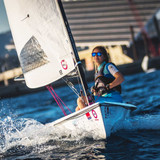
- Qty in Cart
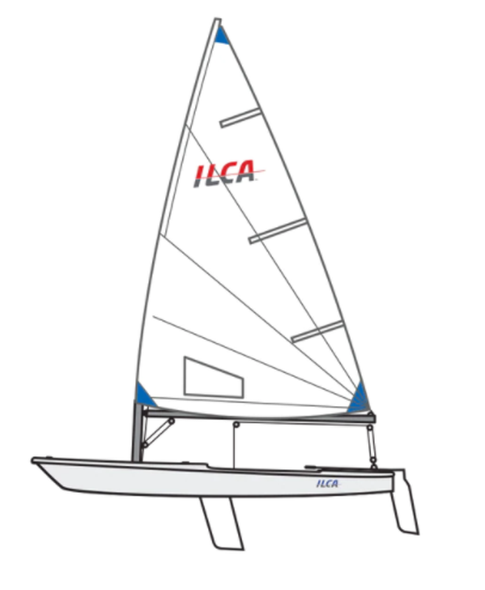
Ovington ILCA - Race

RS Venture Connect

Hobie Mirage Lynx Kayak
- Total: items /
- Add all to cart
Adding your products to cart
Subscribe to our newsletter.
Sign up for our newsletter to receive exclusive discounts, new product announcements, and upcoming sales.
- Share full article
Advertisement
Supported by
In Maine, a Father-Daughter Team Wins a Lobster Boat Race
Jeremy Beal, a boat builder and lobsterman, had a simple strategy: “Point it and punch it!” His 14-year-old daughter took it from there.

By Steven Kurutz
Reporting from Long Island, Maine.
Dozens of boats zipped across Casco Bay during the Maine Lobster Boat Races on Saturday. Only one had a purple bottom.
That boat, a 32-footer with a powerful diesel engine, belonged to Jeremy Beal, 45, a large, soft-spoken man who comes from a long line of boat builders and lobstermen.
“See, I grew up right in it,” he said between drags of a cigarette while leaning against the rail of his boat on the evening before the big race.
For decades, Mr. Beal’s father, Wayne Beal, and an uncle, Calvin Beal, have built boats used by commercial fishers up and down the Maine coast. After years spent learning the family trade, Jeremy took over his dad’s business, Wayne Beal’s Boat Shop, in Jonesport, a seaside town more than 200 miles northeast of Portland.
“I bought the boat off my father,” Mr. Beal said. “It was his last power boat. He’s retired out of the boat shop. I won’t sell the boat unless I have to. Just for the fact that it was my dad’s.”
To pay off the boat, Mr. Beal has returned part-time to lobster fishing, something he first started doing at age 6. This summer he has been helped by his 14-year-old daughter, Mariena Beal, who will enter ninth grade at Jonesport-Beals High School next month.
Together, father and daughter have been dropping 250 traps into the Gulf of Maine to catch thousands of the large lobsters prized around the world for their meat. They split whatever money is left after paying for the bait (herring, mostly), fuel and the monthly boat bill.
Mr. Beal said he hoped the experience would teach his daughter both financial responsibility and the family’s way of life on the water. But Mariena didn’t quite get her way when it came to the color of the boat.
“She wanted a pink bottom, but I wouldn’t let that fly,” he said.
The pair hit on purple as a compromise. And Mariena got to name the boat — My Turn, she called it.

When they are not hauling up traps, Mr. Beal and his daughter have been competing on the lobster boat racing circuit, an annual series of summertime competitions along the Maine coast. The events, run by the Maine Lobster Boat Racing Association, are essentially drag races — the fastest boat wins.
“I’ve always been a competitor,” Mr. Beal said.
He summarized his racing strategy: “Point it and punch it!”
Two days before the recent race, Mr. Beal unloaded the buckets of herring he keeps on deck. He lugged out the lobster crates and the 55-gallon plastic drums that store the catch. Finally, he took a scrub brush and washed down the deck with Dawn dish soap.
On Friday morning, after waking early and packing sandwiches for lunch, Mr. Beal charted a scenic southwesterly course from Jonesport. Alone on deck, he took in the sight of the rocky coastline and marine life, including porpoises. His wife and daughters, including Mariena, drove the 200 miles separately in a car.
It took Mr. Beal just under five hours to sail to Long Island, one of Maine’s Casco Bay islands that lie a few miles from Portland. Many of its 230 residents work on boats or own one.
A crowd had gathered for a cookout at the old boathouse on Wharf Street when Mr. Beal moored his vessel. Men and women were eating hamburgers, drinking beer and lining up to buy race merchandise from Lisa Kimball, an islander who co-chairs the race. The proceeds were going toward a scholarship fund for children on the island.
Mr. Beal made the rounds. Several of the partygoers had bought their boats from him or his father. The price of lobsters was solid this year, everyone agreed, though the catch varied from “good” to “horrible,” depending on who you asked.
Adam Kimball, Ms. Kimball’s husband, planned to race the next day. He works on an oil tanker in Alaska, but you don’t need a commercial fishing license to compete — so long as you have a typical lobster boat, which he does.
“It’s a lot of money to spend for not a lot of return,” Mr. Kimball, 46, said with a laugh.
He was referring to the modest prize money, usually a few hundred dollars, and to the way some boat owners invest thousands to gain horsepower and perhaps a knot or two in speed.
“They call it ‘gooning up’ the engine,” Mr. Kimball said. “There are some risks to that. Like you blow it up.”
Mr. Beal spotted one of the modern legends of the lobster boat racing.
“Stevie Johnson,” he said. “Now there’s a real character.”
Mr. Johnson, the proprietor of Johnson’s Boatyard on Long Island, is known for building unusual boats , some with automobiles mounted on the hulls. One of them, the “Vette-Boat,” features a 1984 Corvette on a 28-foot hull. Mr. Johnson has won his share of races on his tricked-out vessels over the years, but their main purpose is “to cause a scene,” he likes to say.
Dressed in a blue Hawaiian-print shirt, blue board shorts and Crocs, and nursing Canadian Club whiskey and ginger ale in a red plastic cup, Mr. Johnson, who is in his 70s, was trailed by a small entourage at the cookout.
It was getting late. Mr. Beal untied his boat and sailed over to Portland, where a friend was letting him dock while in town.
Mariena had missed the cookout — she was at the Maine Mall, the largest shopping plaza in the state, doing some back-to-school shopping with her mother. The next day, she would be at the wheel of My Turn.
“She’s like me,” Mr. Beal said. “She likes to go fast.”
And the Winner Is …
She also likes to shop. Mariena and her family members missed the noonish start time of the races on Saturday because they had gotten stuck in traffic after spending the morning back at the mall.
Mr. Beal stood at the wheel of My Turn, engine idling, listening to an announcer call the first few races over a marine radio.
At quarter to one, Mariena came bounding down the dock and onto the boat. She wore black shorts, a white North Face long-sleeved top and leather sandals. Her toenails were painted purple, matching the color of her nose ring and the bottom of My Turn.
Like her father, Mariena was reserved. Asked what she liked about racing lobster boats, she replied, “Everything.”
She was joined on the boat by her mother, Maria Beal; her boyfriend, Caleb Geel; her older sister, Caitlin Childers; and Caitlin’s boyfriend, Nick Guptill.
Mr. Beal gunned the throttle and sped toward Long Island. By now, dozens of pleasure crafts and lobster boats were on the water. A crowd of spectators stood at the ferry dock.
Mr. Beal pulled up to the large boat where officials kept watch over the day’s races through binoculars. His passengers disembarked, leaving My Turn for the so-called committee boat.
Then Mr. Beal and Mariena motored toward the starting line, which was nearly a mile north. Once they were among the other boats in their race category — the G classification race, for boats from 28 to 35 feet in length with diesel engines — Mariena took the wheel.
The committee boat was like a floating party, with coolers of food and drinks. Jon Johansen, the bearded president of Maine Lobster Racing, and the publisher of Maine Coastal News , which covers the races, used a telephoto lens to call out the action.
On board, Maria Beal told a story.
Well into the time she was pregnant with Mariena, she said, she had done a lot of lobstering with her husband. That meant hauling up heavy traps to the point that she ruptured her placenta. The doctors thought she would lose the baby.
”But I went to bed for two weeks and it healed up,” Maria said. “And that’s why we named her Mariena — it means ‘lover of the sea.’”
It was now time for the G classification race.
The lead boat was a speck on the water. As it came closer, you could make out its purple bottom leaving a white-capped wake and all the other boats behind it.
Mariena had won, easily. The Beal contingent whooped and cheered.
“She doesn’t have much fear,” her mother said. “Never has. She’s been looking for speed since she was born.”
My Turn sidled up to the committee boat. Amy Tierney, a race co-chair, handed over an envelope of prize money. Mariena was $200 richer.
What did she plan to do with her winnings?
She smiled.
Steven Kurutz covers cultural trends, social media and the world of design for The Times. More about Steven Kurutz
Explore Our Style Coverage
The latest in fashion, trends, love and more..
The Most Wanted ‘Girl’ in Fashion: How did Miu Miu become fashion’s biggest success story — halfway to $1 billion in sales for 2024?
Hairstyle Heat Relief: On a hot day, getting hair off the back of your neck is often the simplest way to start cooling down. The sweeping movement is instinctual, but it is also deeply personal.
Putting the Fun in Funerals: Modern, even hip, mortuaries around the world are hoping to answer one question: How do we commemorate death in 2024 ?
A Shoe That Goes 65 M.P.H.: Our reporter and photographer hit the road for a trip from Maine to Massachusetts in L.L. Bean’s Bootmobile , a promotional vehicle that takes the shape of the company’s duck boot.
The Harris-Walz ‘Visual Age’ Gap: They’re the same age, but pundits and voters can’t stop talking about how much older Governor Tim Walz looks than Vice President Kamala Harris. It’s not the only way he seems to be absorbing some of the scrutiny usually heaped on female candidates.

The High-Adrenaline Racing of SailGP, Where Boats Don’t Float—They Fly
Three-time Rolex Sailor of the Year Tom Slingsby gives us a glimpse into a new sort of sailing.
Ever wanted a new sport to get into? Perhaps one that combines adrenaline, high-tech thrills and spills, and exotic locations? SailGP might be for you. Think of it as Formula 1 on water, with ten nations battling it out in 50-foot-long, 80-foot-tall high-tech racing catamarans powered entirely by the wind. But here’s the thing: They don’t sail. They fly—and fast.
SailGP, founded in 2019, is the brainchild of billionaire sailing nut Larry Ellison and New Zealander Sir Russell Coutts, arguably the most famous and successful competitive sailor in the sport’s history. From the get-go, the pair’s idea was not to create just another race series for yachty insiders but a global, spectator-friendly event that could capitalize on the new advances in sail racing afforded by foiling technology. This year, the season reached 193 million viewers, up 48 percent from 2023. Taking more than a little inspiration from Formula 1, SailGP set out to attract non-sailors to this burgeoning sport, partly by staging the races in nontraditional waters, like Abu Dhabi, Bermuda, and Halifax, Nova Scotia.

Since its inception, the SailGP competition has been sponsored by Rolex, which has long been a supporter of all manner of sailing. Last year, the brand extended its support by ten more years. As well as a $2 million purse for his team, the winning skipper at the grand finale, which this season took place below the Golden Gate Bridge in San Francisco, receives a titanium Yacht-Master II.
Many of sailing’s luminaries are also key members of Rolex’s Testimonee program, evangelizing for both sailing and its unique connection with ocean sustainability. One of them is Tom Slingsby, helm and CEO of SailGP’s Team Australia and three-time Rolex Sailor of the Year. At the top of his game, Slingsby, 39, has carried off three of the four SailGP championships for Team Australia since it began in 2019.
Foiling, just a decade-and-change old, has transformed competitive sailing. Put simply, thanks to the physics of hydrostatic pressure, by sailing on carbon-fiber blades, an entire 50-foot racing catamaran can lift itself out of the water, reducing the drag coefficient to almost nothing and producing speeds unimaginable just 15 years ago. Often this means the boat moves three, even four times faster than the wind.

“You see spectators’ faces when you go past them doing nearly 100 kilometers an hour on the water and at four times the wind speed,” Slingsby says. “It’s unbelievable.” Foiling has almost doubled competitive sailing’s top speed—and it’s getting faster all the time. Not that speed is really the aim here.
“I don’t think it’s SailGP’s goal to set an outright speed record or anything like that,” Slingsby explains. “What we want is a good racing product. Our hydrofoils don’t need to just go super fast in a straight line; they need to go around a racetrack efficiently, to take off in light airs and sail well in strong airs, and be maneuverable when tacking and jibing.”
But getting there requires both skill and experience in a fast-evolving sport, as well as an array of technology and data gathering. So called “aviation officers” on each team have one job: to keep the race boat flying on its foils in constantly changing conditions. When they don’t, interesting things can happen.
Slingsby will probably race any boat you put in front of him. There’s a reason for that. “In the Olympics in 2008,” he says, “I went in as a favorite to win the Laser gold medal and I choked—basically I finished 22nd. Then my good friend Nathan Outteridge [a fellow Australian and helm of SailGP Team Switzerland] was leading going into the final race and ended up coming away with fifth and missing a medal. We were both really depressed. We were sitting having a beer after the Olympics and he said, ‘We’ve just got to sail more. Let’s just sail every type of boat, learn every type of skill, and that way we will be hard to beat.’”
Slingsby (and Outteridge) did just that, diving headfirst into the nascent sport of foiling at just the right time. Both went on to win Olympic golds.
“I’m very fortunate that I actually got to be part of sailing before foiling came along,” Slingsby says. “I went to the Olympics in Lasers, probably the simplest boat in the world, and then I was there when the America’s Cup boats started hydrofoiling. Now I’m here now with SailGP, the fastest and most amazing foiling league in the world, and it’s really taking our sport to new levels.”

Unlike Formula 1, there’s a deliberately bare-bones vibe to the infrastructure of SailGP to make the whole competition as environmentally sustainable as possible. The tagline is, after all, “Powered by Nature.”
“SailGP is at the top of the sport,” Slingsby explains, “so it filters down through the whole of sailing. We see and deal with ocean health every day; we see it much more than, say, tennis players do, or F1 drivers, or track athletes. We’re out there dealing with Mother Nature; it’s probably just us and surfers. It’s our responsibility to raise awareness.”
Off the water, the Impact Awards challenge GP teams to come up with ingenious ways to reduce waste and save on resources. For instance, the race catamarans—which all have the same design—were designed so they can be disassembled and fit into a single 40-foot container.
The benefit of one-design racing is that it levels the playing field. Skill becomes much more pivotal. Each boat has around 160 electronic sensors, tracking every setting of the boat, especially below the waterline, where the angle of attack of the foils is critical. Win or lose, at the end of a race day, all those recorded settings are beamed straight to the cloud and are immediately accessible to the other teams and their tacticians.

“Initially, I really didn’t like it,” says Slingsby of the data sharing. “We were the top team, and every day we’d go out and be losing advantage to our competitors because they would see our data from that day, and they were getting closer and closer. But now, I think it’s just good for SailGP. The racing is so much tighter.”
Tighter, but also more human. While material failures account for a proportion of crashes, decisions made by a skipper in a split second—or simply a split second too late—can throw out a whole race.
Another curiosity of SailGP is the way the finals are set up. The point system gives the race winner ten points, second place receives nine points, and so on. But the finals are where it gets interesting. The grand-finale weekend consists of five qualifying fleet races featuring all ten teams, and then the final race itself. Only the top three teams get to race in the final, with their seasonal scores effectively erased. Which means a team could be third overall for the season and still win the grand finale in the last few minutes of the season. It makes for a gripping race.

That’s precisely what happened last month in San Francisco, where third-place Spain, skippered by Diego Botin, edged out league leaders New Zealand and Australia in a race that lasted just ten minutes.
Slingsby, for his part, is currently in Barcelona, where that other great sailing race, the America’s Cup, is underway. SailGP’s 2024-25 season kicks off in November in Dubai. Two new teams are rumored to be joining the fray, attracted by the unique approach to racing established for SailGP.
“The America’s Cup is a development game,” says Slingsby. “You design your own boat and you’re just trying to make it the fastest you possibly can on the water. Essentially, you’re in training boats for three years and then you get three or four months in your actual race boat. You really do one important event in four years. With SailGP, we get to race for a full season every year. So for sure, SailGP is my favorite thing to do, because it’s consistent racing every month. Me, I’m a racer.”
Nick Sullivan is Creative Director at Esquire, where he served as Fashion Director from 2004 until 2019. Prior to that, he relocated from London with his young family to Boerum Hill, Brooklyn. He has styled and art directed countless fashion and cover stories for both Esquire and Big Black Book ( which he helped found in 2006) in exotic,uncomfortable, and occasionally unfeasibly cold locations. He also writes extensively about men’s style, accessories, and watches. He describes his style as elegantly disheveled.
@media(max-width: 73.75rem){.css-1ktbcds:before{margin-right:0.4375rem;color:#FF3A30;content:'_';display:inline-block;}}@media(min-width: 64rem){.css-1ktbcds:before{margin-right:0.5625rem;color:#FF3A30;content:'_';display:inline-block;}} Sports

The Slow Death of the Starting Pitcher

Are Judge and Soto the Best Hitting Duo Ever?

Tom Cruise(d) Into the Olympics Closing Ceremony

Formula 1’s Lewis Hamilton on Winning Again

Olympic Scandals You Totally Forgot About

A Century of Team USA's Opening Ceremony Outfits

A New HBO Doc Is Pete Rose’s Last Stand

Will Pete Rose Ever Grow Up?

15 Golf Deals We're Shopping From Amazon Prime Day

Mike Tyson Takes One Last Swing at Immortality

18 Weird Olympics Facts Through the Years

- The Star ePaper
- Subscriptions
- Manage Profile
- Change Password
- Manage Logins
- Manage Subscription
- Transaction History
- Manage Billing Info
- Manage For You
- Manage Bookmarks
- Package & Pricing
Dragon boat race to make a splash
Tuesday, 27 Aug 2024
Wong (left) launching the official website of Dragon Boat Regatta 2024 at Komtar. With him are (from second left) Ding, HKETO Jakarta deputy director Danial Chan and other event guests. — KT GOH/The Star
THE Penang 45th International Dragon Boat Regatta at the Teluk Bahang Dam is scheduled for Nov 23 and 24, with the current low water levels expected to improve by then.
Penang tourism and creative economy committee chairman Wong Hon Wai noted a wet spell has been forecast at the end of the year.
He shared that nevertheless, contingency plans were in place so that the regatta could be held as scheduled.
Speaking at a press conference in Komtar, Wong said that over 60 teams from various countries would be taking part in the event.
“This annual event promises to be a spectacular showcase of cultural heritage, international sportsmanship and fierce competition, with teams from around the world expressing interest in participating,” he said.
“It has attracted teams from as far as the United Arab Emirates, the Netherlands and United Kingdom.”
Wong also pointed out that this year is the 50th anniversary of diplomatic relations between Malaysia and China.
“This year’s festival will feature a special friendship celebration event.
“We are honoured to collaborate with the Consulate General of the People’s Republic of China in Penang to mark this significant milestone, reflecting the deep and enduring ties between our two nations,” he said.
Wong added that Penang was collaborating with the Hong Kong Economic and Trade Office (HKETO) in Jakarta to foster ties and boost participation.
“This partnership is aimed at encouraging more teams from Hong Kong to join the festival, to further enrich the event with diverse participation,” he said.
China’s acting consul general in Penang Ding Qiao, who was present, said that the dragon boat race was deeply embedded in the cultural fabric of the state.
“Originating from the traditional Chinese Dragon Boat Festival, which dates back over 2,000 years and celebrates the Chinese scholar and poet Qu Yuan, the event has grown significantly.
“Initially featuring mainly local teams, it has now become a global event with international teams competing, enhancing the festival’s cultural exchange and global unity,” she said.
According to her, China would send five teams while Hong Kong and Taipei would have nine teams and one team, respectively.
The Penang dragon boat race has a storied history that dates back to the 1950s.
In 1956, there was a dragon boat race to mark the centennial of the establishment of the municipality of George Town.
In 1977, Penang sent a 30-member team to compete in the Hong Kong Dragon Boat Race Festival.
On July 8, 1979, Penang hosted the inaugural Penang International Dragon Boat Festival with 66 teams from Indonesia, Singapore, Hong Kong and Malaysia.
For more information, visit www.penangdragonboat.gov.my
Found a mistake in this article?
Report it to us.
Thank you for your report!
MBAM OneBuild 2024 returns for its 10th edition
Next in metro news.

Trending in Metro
Air pollutant index, highest api readings, select state and location to view the latest api reading.
- Select Location
Source: Department of Environment, Malaysia
Others Also Read
Best viewed on Chrome browsers.

We would love to keep you posted on the latest promotion. Kindly fill the form below
Thank you for downloading.
We hope you enjoy this feature!
- AROUND THE SAILING WORLD
- BOAT OF THE YEAR
- Email Newsletters
- America’s Cup
- St. Petersburg
- Caribbean Championship
- Boating Safety
- Ultimate Boat Giveaway

Helly Hansen Sailing World Regatta Series
Embracing popular fleets at each location, the Regatta Series features many different boat types: dinghies, multihulls, and keelboats that race under established handicap systems.
Latest News

Sailing World ’s 2024 Boat of the Year Competition
Five Boat of the Year 2024 nominees have been chosen as the defining performance sailing designs for those seeking a new ride in the new year.

Fletcher In, Scott Out with INEOS Starting Lineup Annoucement
Cruising cat racing franco style, the marvelous ac75s on deck, the caribbean’s hot one-design fleet, cole brauer’s voyage of influence, new extremes on the horizon, more stories, rs fest miami gets the tribe together, regatta series rolls into marblehead, wildcat’s wild race to alaska, the building blocks of asymmetric spin trim.

- Digital Edition
- Customer Service
- Privacy Policy
- Terms of Use
- Cruising World
- Sailing World
- Salt Water Sportsman
- Sport Fishing
- Wakeboarding
- Today's news
- Reviews and deals
- Climate change
- 2024 election
- Newsletters
- Fall allergies
- Health news
- Mental health
- Sexual health
- Family health
- So mini ways
- Unapologetically
- Buying guides
Entertainment
- How to Watch
- My watchlist
- Stock market
- Biden economy
- Personal finance
- Stocks: most active
- Stocks: gainers
- Stocks: losers
- Trending tickers
- World indices
- US Treasury bonds
- Top mutual funds
- Highest open interest
- Highest implied volatility
- Currency converter
- Basic materials
- Communication services
- Consumer cyclical
- Consumer defensive
- Financial services
- Industrials
- Real estate
- Mutual funds
- Credit cards
- Balance transfer cards
- Cash back cards
- Rewards cards
- Travel cards
- Online checking
- High-yield savings
- Money market
- Home equity loan
- Personal loans
- Student loans
- Options pit
- Fantasy football
- Pro Pick 'Em
- College Pick 'Em
- Fantasy baseball
- Fantasy hockey
- Fantasy basketball
- Download the app
- Daily fantasy
- Scores and schedules
- GameChannel
- World Baseball Classic
- Premier League
- CONCACAF League
- Champions League
- Motorsports
- Horse racing
New on Yahoo
- Privacy Dashboard
Great Cardboard Boat Race sets new records
ELKHART — Results of the Great Cardboard Boat Race, sponsored by Winnebago Industries to benefit Crossroads United Way, were “nothing short of extraordinary,” organizers said.
The event Friday saw record-breaking attendance and boat participation, solidifying its place as one of the community’s most anticipated events of the year, the group said.
With over $160,000 raised and counting, Crossroads United Way again surpassed its fundraising goals, thanks to contributions from participants, sponsors and the local community. The funds will be directed toward supporting vital programs in the region, focusing on early childhood education, mental health and other critical services.
“We are overwhelmed by the community’s support and enthusiasm,” said Bill Purcell, president and CEO of Crossroads United Way. “This event not only brings people together for a day of fun but also makes a lasting impact on the lives of so many in our area.”
Highlights and winners
The competition was fierce, with each team showcasing their creativity and engineering prowess. Below are the heat winners and overall race results:
Race 1 Winner: Himco/Borden (Average Joe’s)
Race 2 Winner: Utilimaster (Kong)
Race 3 Winner: Thor Motor Coach (Jurassic Park)
Race 4 Winner: Welch Packaging (Cal)
Race 5 Winner: Godfrey Marine (Easy Rider)
Race 6 Winner: Utilimaster (Misfit Toys)
Race 7 Winner: Utilimaster (Barbie)
Race 8 Winner: NIBCO (Queen Anne’s Revenge)
First Responders Race Winner: Bristol Fire Department
Cardboard Crusader Award: Himco/Borden (Globo Gym)
In the final race, Welch Packaging (Cal) took the top spot, followed by Utilimaster (Goonies) in second place and Thor Motor Coach (Jurassic Park) in third.
People’s Choice Awards: The coveted People’s Choice Awards, based on crowdfunding dollars raised, were won by LaSalle Bristol and Grand Design, showcasing the power of community engagement and support.
In a release Monday, Crossroads United Way expressed its gratitude to all participants, volunteers, sponsors and spectators.
“The Great Cardboard Boat Race continues to be a cornerstone event, driving community spirit and support for United Way’s mission,” the organization said.
More information: www.crossroadsuw.org .
Recommended Stories
Aaron judge does it all, this time with a home-run robbing double-play gem.
Judge can do it with his glove too.
Mosquito-borne illnesses are back in the news. 4 ways to protect yourself.
Cases of West Nile virus, dengue and deadly Eastern equine encephalitis have all been reported in the U.S. this summer.
Caitlin Clark's Next WNBA Game: How to watch the Indiana Fever vs. Atlanta Dream game tonight
Watch Caitlin Clark's next WNBA game when the Indiana Fever play the Atlanta Dream tonight.
'Extraordinary' earbuds for just $17? Yes, this nearly 70% off deal is for real
With 32 hours of playback time and a fast one-hour recharge, these will be your best buds.
What is an IRA CD?
If you think a CD could help you meet your retirement savings goals, an IRA CD might be a good fit. Here’s a closer look at what an IRA CD is and how it works.
Thinning hair? These early Labor Day deals on fave brands start as low as $6
Everything you need to make your mane look lustrous, including thickening shampoos, oils, styling products and Nutrafol's popular supplements — all on sale!
Potatoes are good for you — but they get a bad rap. Why spuds are healthier than you think.
Potatoes aren't just "empty calories." They contain more potassium than a banana and even provide protein.
We're snapping up these podiatrist-loved shoes and sandals, on sale from $30
Our expert-vetted picks offer comfort, support and style — plus some are over 50% off.
Polaris Dawn will push the limits of SpaceX's human spaceflight program -- here's how to watch it launch live
After a nearly three-year interlude, Jared Isaacman is returning to space. The billionaire entrepreneur first went to orbit as part of the Inspiration4 mission, which made history for having a crew comprised entirely of private citizens, not professional astronauts. Literally: Polaris Dawn will fly farther than any mission using SpaceX’s Dragon capsule to date, while also soaring through portions of the Van Allen radiation belt for the first time since the days of the Apollo missions.
California AI bill sparks debate in Silicon Valley as some tech giants call it a threat to innovation
A controversial AI regulation bill is sparking a fierce debate in Silicon Valley. California legislatures will vote on SB 1047 this week. If passed, it would broadly regulate how AI is deployed and developed.
Arsenal & Chelsea with statement wins, Columbus Crew continue dominance & the boys debut a new segment
Christian Polanco and Alexis Guerreros break down strong performances from Arsenal and Chelsea last weekend. They also react to the Leagues Cup final and break down the current situation with the San Diego Wave. The boys then debut their new segment, “Oh For Real!?”
Today's best sales: A $40 chainsaw, a Shark vac for $100 and CeraVe for 50% off
You can also save on a popular Insignia Fire TV, a gorgeous Coach handbag, a beginner-friendly drone, comfy leggings and more.
I'm a former assistant stylist — here's what I use to stop wardrobe malfunctions
These problem-solvers are small enough for travel, and prices start at just $5.
Labor Day sales are here early: Huge Amazon savings and the best deals we could find on tech, appliances, clothing and more
Dyson, Home Depot, Macy's, Tempur-Pedic: We're still days away from the big sale weekend, but prices have already plummeted.
Indiegogo introduces its new guaranteed shipping program
Indiegogo introduces its guaranteed shipping program for selected campaigns that qualify. Buyers get their money back if orders don't ship on time.
Elevate your brand’s impact: Host a Side Event at TechCrunch Disrupt 2024
Maximize your brand's presence by hosting your Side Event in San Francisco during Disrupt Week — October 26 through November 1. Connect with more than 10,000 attendees of Disrupt 2024, as well as your network and the dynamic Bay Area tech community. Why host a Side Event?
Anthropic publishes the 'system prompts' that make Claude tick
Every generative AI vendor, from OpenAI to Anthropic, uses system prompts to prevent (or at least try to prevent) models from behaving badly, and to steer the general tone and sentiment of the models' replies. The only way to expose GPT-4o's system prompt, for example, is through a prompt injection attack.
Palico is now the first FINRA-approved company to facilitate online LP-led secondaries deals
Limited partners selling their investment stakes in venture capital funds to other LPs on the secondary market is nothing new. Palico is looking to change that. Paris-based Palico quietly got approval from the Financial Industry Regulatory Authority (FINRA) in July to be the first company able to facilitate end-to-end LP secondaries transactions online as an electronic trading system (ETS).
How college students can use credit cards responsibly
Use these tips to responsibly manage and build your credit in college and beyond. Credit cards for college students can lead to more rewarding opportunities.
What credit card users need to know if the Fed cuts rates in September
The Fed may soon cut interest rates. Here’s why you should take control of your credit card debt now.

COMMENTS
Dinghy racing is a competitive sport using dinghies, which are small boats which may be rowboats, have an outboard motor, or be sailing dinghies. Dinghy racing has affected aspects of the modern sailing dinghy, including hull design, sail materials and sailplan, and techniques such as planing and trapezing . Newport Harbor High School sailing team.
1. Twelve of the best training boats Sailing schools, clubs and training centers use a variety of boats with beginners, including singlehanders such as the Pico, Hartley 10 and the RS Quba, the latter having three rigs catering from entry level to more experienced sailors. There's also a range of larger training dinghies from builders such as RS, Topper, Laser and Hartley Boats.
#dinghy #racing #performance #sailing #club #regatta International 14 footage courtesy of http://www.vrsport.tv https://www.youtube.com/channel/UC2kpqNdHC_Hi...
Looking for Dinghy Racing Strategy, Top Tips, Features, Rules and Events? You're in the right place.
Dinghy sailing - whether racing or as a leisure activity - is one of the best ways to improve your skill level whether you've no experience of sailing, race 50ft yachts offshore or cruise ...
A sailing dinghy is a small boat typically designed for one to four individuals. It features a single mast with a mainsail and often has additional sails like jibs or spinnakers. The compact size and maneuverability of dinghies make them excellent vessels for racing or recreational sailing purposes. 2.
These tough, abrasion-resistant hulls have a bumper boat tolerance thats a big plus when it comes to kids learning to sail. Best of all, owners can start with a learn-to-sail rig and upgrade to a more performance-oriented mast and sail package (41 or 56 square feet) that kicks performance into the fast lane.
The Happy Cat Hurricane is an 18-foot inflatable sailing catamaran built of high-quality rubber. The boat is designed for recreational adventure sailing and racing, as well as portability. Sailing ...
Tiwal 3R 2023 Best Dinghy. Stated purpose: Recreational sailing, one-design and rally racing. Crew: One to two. Praise for: Performance, comfort, portability. Est. price as sailed: $8,900. The ...
Many sailing clubs offer dinghy racing programs, providing an opportunity to socialize, improve sailing skills, and compete with like-minded individuals. The Rising Popularity of Inflatable Sailing Catamarans. In recent years, inflatable sailing catamarans have gained popularity for their unique design and features. 1. Advantages of Inflatable ...
Join the Snipe Class! Serious Sailing, Serious Fun. The Snipe is a two person dinghy that brings the well-balanced class motto "serious sailing, serious fun" to life at every regatta.It's a class we can grow old in, with age-appropriate challenges and opportunities for every generation.. The Snipe Class International Racing Association (SCIRA) is a widely popular and well run ...
The start of a race is often the most confusing part of a regatta and is where the most flags must be used. We will be going over the rules for the flags at a basic 5-minute start. These can be modified for 3-minute dinghy starts, 5-minute match race starts, 6-minute Olympic starts, or 10-minute big boat starts, but the same logic applies. Pre ...
There are many types of racing sailboats that range from one-man dinghies all the way to 100-foot yachts. Some racing sailboats are classified as keel boats, multi-hull, and even a tower ship. These boats are built primarily for speed, so comfort is usually an afterthought depending on the brand. For racing sailboats, each one is going to fit ...
The design of a racing sailing dinghy is very important, but the skills of the crew on-board are usually what matters the most. Again, these types of sailing dinghies are made out of fiberglass. The tactics implemented by the crew on a racing sailing dinghy are incredibly important. A racing sailing dinghy allows for crews to take advantage of ...
49er skiffs in a race 49ers at the Extreme Sailing Series in Boston harbor preparing to race, 4th of July, 2011. The 49er made its first Olympic appearance at the Sydney Olympics in 2000 and has continued to grow in popularity ever since. With a Portsmouth yardstick Handicap of 740 the 49er is the fastest two person one-design monohull dinghy.
Racing a sailboat is a lot of fun. It blends the excitement of sailing your own boat with the raw rivalry of trying to beat another boat of comparable size. Racing also teaches you boat handling and sail trim in a manner that cruising cannot: by comparing your speed and handling to those of other boats. Let us jump into the article to learn ...
4) Sunfish. thedougabides13. The Sunfish is a brilliant little sailboat, and a very fast boat indeed. This little racing dinghy, while only 13 feet in length, can be an enormous amount of fun for beginners and experienced sailors alike.
Every control was easy to pull, and the nonskid had excellent grip.". Sailing World Magazine's Best Dinghy of 2024 is the RS Toura, a 15-foot rotomolded plastic dinghy designed for sailing ...
The Official Website of SailGP - get the latest sail racing news, calendar, results, rankings and schedule. Skip to Main Content. Dubai 23 - 24 Nov 2024. 00. Days: 00. Hours: 00. Minutes: 00. Seconds ... Sailing as Spain's Florián Trittel . 08 August 2024 videos. WATCH: The Best Mic'd Up Moments from San Francisco.
Sailing. The dinghy is one of the few boats left that offer a sailing configuration. If you're into boating on lakes or thinking about sailing competitively, the dinghy is the best choice. Any of the sailing models listed above are a great choice. Pick the boat that offers you the best utility for your sailing needs. Minimal Noise
Sailboat Racing. Stay up-to-date with the latest sailboat racing news, results and upcoming regattas. ... Wanderers of the Wayfarer Dinghy More One-Design. Volvo Ocean Race.
Dylan, 10, son of Elizabeth Crites of Conestoga, works his boat the Crick Rat down the Pequea Creek during the 3rd annual Music for Everyone fundraiser at Sickman's Mill on Sunday, Sept. 17, 2023.
Ovington ILCA - Race. Ovington Boats. $9,495.00 - $9,695.00. The most popular single handed one-design sailboat of all time. The ILCA is a single-handed racing dinghy with over 200,000 boats in 140 countries, it is the world's most popular adult and youth racing sailboat. This makes it one of the most...
The Boat Race is a side-by-side rowing competition between the men's senior boat clubs of the University of Oxford (sometimes referred to as the "Dark Blues") [1] and the University of Cambridge (sometimes referred to as the "Light Blues"). [1] The race was first held in 1829 on a 2 + 1 ⁄ 4-mile (3.6 km) stretch of the River Thames. [2] For the women's senior boat clubs race see "The Women's ...
Dozens of boats zipped across Casco Bay during the Maine Lobster Boat Races on Saturday. Only one had a purple bottom. That boat, a 32-footer with a powerful diesel engine, belonged to Jeremy Beal ...
Slingsby will probably race any boat you put in front of him. There's a reason for that. "In the Olympics in 2008," he says, "I went in as a favorite to win the Laser gold medal and I ...
In 1956, there was a dragon boat race to mark the centennial of the establishment of the municipality of George Town. In 1977, Penang sent a 30-member team to compete in the Hong Kong Dragon Boat ...
The largest unsanctioned charity boat race in the U.S. returns to the Lake of the Ozarks this weekend. The 2024 Lake of the Ozarks Shootout boat races are scheduled this Saturday and Sunday ...
Sailing World is your go-to site and magazine for the best sailboat reviews, sail racing news, regatta schedules, sailing gear reviews and more.
ELKHART — Results of the Great Cardboard Boat Race, sponsored by Winnebago Industries to benefit Crossroads United Way, were "nothing short of extraordinary," organizers said. The event ...